#kakadu accommodation
Explore tagged Tumblr posts
Text
The Timeless Beauty of Katherine Gorge: A Must-See Destination in the Northern Territory
Introduction
Nestled in the heart of Australia's rugged Northern Territory, Katherine Gorge is a breathtaking natural wonder that draws visitors from around the world. Located within Nitmiluk National Park, this iconic landmark is a testament to the timeless beauty of the Australian Outback. With its towering sandstone cliffs, crystal-clear waters, and lush surrounds, Katherine Gorge offers a stunning landscape that is both serene and awe-inspiring.
But Katherine Gorge is more than just a picturesque destination—it’s a place steeped in rich cultural significance, home to the ancient Jawoyn people, whose connection to the land spans tens of thousands of years. Whether you're seeking adventure through kayaking and hiking or looking to explore the rich heritage and wildlife of the area, Katherine Gorge offers something for everyone. This article will take you on a journey through the gorge's natural wonders, cultural history, and the unforgettable experiences that make it a must-see destination in the Northern Territory.
Introduction: Discovering Katherine Gorge
Katherine Gorge, located within the stunning Nitmiluk National Park in the Northern Territory, is a true gem of Australia's outback. Known for its dramatic landscapes, towering sandstone cliffs, and crystal-clear waters, Katherine Gorge captivates visitors with its natural beauty and rich cultural history. The gorge, which stretches for 13 kilometers, is a series of spectacular gorges carved by the Katherine River, offering a diverse range of experiences for nature lovers, adventure seekers, and cultural enthusiasts alike.
This awe-inspiring destination is not just about striking scenery; it’s a place of profound cultural significance for the Jawoyn people, the traditional custodians of the land. With over 40,000 years of Aboriginal history, Katherine Gorge is deeply tied to the stories, legends, and traditions of the Jawoyn. The gorge’s cliffs and rock formations serve as a canvas for ancient rock art, telling the stories of the Dreamtime and providing insight into the region’s long history.
Visitors to Katherine Gorge are welcomed with a range of outdoor adventures, including kayaking along the tranquil river, hiking through rugged trails, and taking boat cruises to explore the picturesque gorges. Whether you’re looking for relaxation or seeking an adrenaline-fueled experience, Katherine Gorge offers something for everyone. With its untouched wilderness, abundant wildlife, and cultural depth, Katherine Gorge is truly a must-see destination that provides an unforgettable glimpse into the heart of Australia’s natural and cultural heritage.
A Geological Marvel: The Formation of Katherine Gorge
Katherine Gorge is a stunning testament to the power of nature, shaped over millions of years by geological forces that have carved out its dramatic landscapes. The gorge’s towering sandstone cliffs, narrow waterways, and striking rock formations tell the story of a deep and ancient history, offering visitors a glimpse into the earth's geological past.
The gorge was primarily formed through erosion and the gradual movement of the Katherine River. Over 20 million years ago, during the Tertiary period, the region was covered by ancient seas. As the seas receded, the area was left with layers of sedimentary rock, including sandstone, limestone, and shale. Over time, the Katherine River began to carve its path through these rock layers, creating a network of deep gorges, waterfalls, and ravines.
The river’s continuous flow, combined with the pressure of geological forces, has shaped the distinctive landscape of Katherine Gorge. The sandstone cliffs, which rise dramatically from the river, were once part of vast ancient mountains. These cliffs have withstood the test of time, with some reaching over 70 meters in height. As the river eroded the softer rock layers, it exposed the more resistant sandstone, creating the awe-inspiring cliffs that define the gorge today.
In addition to the gorge's rock formations, the region is home to karst landscapes, a type of landscape shaped by the dissolution of soluble rocks such as limestone. This geological feature is evident in the park's cave systems and limestone ridges, which have been carved by water over millennia. These features add to the beauty and complexity of the region, offering opportunities for exploration and discovery.
The formation of Katherine Gorge is not only a marvel of nature but also a reminder of the enduring forces that have shaped the Australian landscape. As you explore the gorge, it’s impossible not to be awed by the sheer scale and beauty of this geological wonder, a landscape that has been sculpted over millions of years and continues to captivate visitors today.
Cultural Heritage: The Aboriginal Connection to Katherine Gorge
Katherine Gorge holds profound cultural and spiritual significance for the Jawoyn people, the traditional custodians of the land. For thousands of years, the gorge has been an integral part of their way of life, shaping their stories, customs, and spiritual beliefs. The Jawoyn people’s connection to the land is deeply embedded in the region’s natural beauty, and their enduring bond with Katherine Gorge is reflected in the many sacred sites, rock art, and Dreamtime stories that are found throughout the area.
The Jawoyn have lived in the Katherine region for over 40,000 years, and their ancestors’ stories are closely tied to the landscape of Katherine Gorge. The river, cliffs, and surrounding bushlands are not only natural features but also living cultural landmarks, with each site carrying its own significance in the Jawoyn belief system. The gorge is seen as a place of spiritual power and a living reminder of the Dreamtime—the period in Aboriginal mythology when the world was created by ancestral beings. These beings are said to have created the landforms, waterways, and animals that the Jawoyn people still revere today.
One of the most striking aspects of Katherine Gorge is its rock art. These ancient paintings, which are found on the cliff faces and caves throughout the gorge, are a testament to the Jawoyn people's long history in the area. The rock art depicts scenes of animals, hunting, and rituals, as well as ancestral figures tied to the Dreamtime. These artworks serve as both a historical record and a spiritual connection, passing down knowledge from generation to generation. Many of the sites are considered sacred, and they hold special meaning for the Jawoyn people, who continue to care for and protect them.
In addition to the rock art, the Katherine River itself holds great spiritual importance for the Jawoyn. The river is seen as a lifeline, providing sustenance and a pathway for both travel and communication. It is deeply intertwined with the stories of creation and is still a source of cultural connection for the Jawoyn people, who continue to use the river for traditional purposes such as fishing, gathering food, and ceremonial practices.
Today, the Jawoyn people welcome visitors to Katherine Gorge and invite them to learn about the cultural significance of the area. Guided tours led by local Aboriginal guides offer invaluable insights into the traditional stories and customs of the Jawoyn, as well as the cultural landscapes that make Katherine Gorge such a special place. These tours provide a deeper understanding of how the Jawoyn people have lived in harmony with the land for millennia, and how their cultural heritage continues to shape the way they interact with the gorge today.
By respecting and engaging with the cultural heritage of Katherine Gorge, visitors can gain a richer, more meaningful experience of this extraordinary natural wonder. It is not just a place of beauty, but a living testament to the Jawoyn people’s enduring connection to the land—a connection that spans thousands of years and remains as strong today as ever.
Exploring the Landscape: Outdoor Adventures in Katherine Gorge
Katherine Gorge, nestled within Nitmiluk National Park, offers a diverse range of outdoor adventures that allow visitors to immerse themselves in the stunning landscape. From tranquil canoe rides to challenging hikes and scenic boat cruises, there are numerous ways to explore the natural beauty of this iconic destination. Whether you’re seeking a peaceful retreat or an adrenaline-pumping adventure, Katherine Gorge has something to suit every level of adventurer.
Canoeing and Kayaking One of the most popular ways to explore Katherine Gorge is by canoe or kayak. Paddling along the Katherine River allows you to experience the gorge from a unique perspective, gliding through narrow, winding waterways surrounded by towering sandstone cliffs. As you paddle, keep an eye out for local wildlife such as freshwater crocodiles, wallabies, and a variety of bird species. Visitors can hire canoes or kayaks for a self-guided tour, or join a guided tour to learn more about the gorge’s natural and cultural significance. Canoeing through the gorge is a peaceful and intimate way to connect with the land, offering moments of serenity as you navigate through the picturesque waterways.
Boat Cruises For a more relaxed yet equally stunning experience, boat cruises are a fantastic way to take in the beauty of Katherine Gorge. These guided cruises take you along the river, winding through the gorge’s narrow passages and past sheer cliffs that rise dramatically above the water. The cruises provide informative commentary about the gorge’s geology, Aboriginal culture, and wildlife, making it an educational and scenic experience. As you cruise through the gorge, you’ll have the chance to witness the ever-changing landscape, with vibrant colors and textures that shift depending on the time of day and weather conditions.
Hiking and Walking Trails For those who love to explore on foot, Katherine Gorge offers several hiking trails that range in difficulty, providing visitors with the chance to discover the park’s diverse landscapes up close. The Baruwei Lookout Trail is one of the most popular short hikes, offering stunning panoramic views of the gorge and its surroundings. This relatively easy trail takes you to a lookout point where you can enjoy breathtaking views of the river below and the surrounding cliffs. For those seeking a more challenging hike, the Jatbula Trail is a 62-kilometer multi-day trek that takes you through a variety of landscapes, from rocky outcrops and waterfalls to dense forests and river crossings. This iconic trail offers hikers a chance to fully immerse themselves in the park’s wilderness, with camping spots along the way for a true outback adventure.
Swimming at Edith Falls After a day of hiking or exploring, you can cool off in the natural swimming pools at Edith Falls (also known as Leliyn). Located a short drive from Katherine Gorge, Edith Falls is a picturesque spot where visitors can take a refreshing swim in the crystal-clear waters beneath a cascading waterfall. The area is surrounded by lush vegetation and offers a peaceful setting to relax and enjoy the natural beauty of the region. Edith Falls is also home to several walking trails, including a short circuit to the lower pools and a longer hike to the upper pools for even more stunning views.
Wildlife Watching and Birdwatching Katherine Gorge is home to a wide variety of wildlife, making it a haven for nature lovers and wildlife enthusiasts. While canoeing, cruising, or hiking, you may encounter freshwater crocodiles, rock wallabies, and a rich array of bird species such as white-bellied sea eagles, jabiru storks, and brolgas. The park is also home to a number of unique plants and animals, some of which are endemic to the region. For birdwatchers, Katherine Gorge offers a fantastic opportunity to spot a wide range of species in their natural habitats, making it a great destination for both novice and experienced birdwatchers.
Camping and Stargazing For those wanting to fully immerse themselves in the outback experience, camping in Nitmiluk National Park is a great way to extend your adventure. The Nitmiluk Campground offers a range of facilities, including powered sites and amenities, while providing an excellent base for outdoor activities. The night skies in the Northern Territory are known for their exceptional clarity, making it a perfect spot for stargazing. With minimal light pollution, you’ll have the chance to witness the Southern Hemisphere’s stars and constellations in all their glory, offering a magical end to your day’s adventure.
From canoeing and hiking to swimming and stargazing, exploring Katherine Gorge is a truly unforgettable experience. Whether you’re looking for relaxation or excitement, the park offers a variety of activities that allow you to connect with its spectacular natural beauty, making Katherine Gorge a must-see destination for adventurers and nature lovers alike.
Wildlife and Natural Habitats: A Sanctuary of Life
Katherine Gorge, located within Nitmiluk National Park, is not only a geological and cultural marvel but also a vibrant sanctuary of wildlife. The diverse ecosystems of the park provide a safe haven for a wide range of animals, many of which are unique to the Northern Territory’s rugged outback. From the waters of the Katherine River to the surrounding woodlands and sandstone cliffs, the park’s habitats support a rich array of plant and animal life, making it a prime destination for nature enthusiasts and wildlife watchers.
Aquatic Life in the Katherine River The Katherine River that winds through the gorge is teeming with life, offering an ideal environment for aquatic species. Freshwater crocodiles, one of the park’s most iconic inhabitants, can often be spotted basking on the riverbanks or swimming lazily through the water. These ancient reptiles, while not dangerous to humans, are an important part of the ecosystem, helping to maintain the balance of the river’s aquatic life. The river is also home to various species of fish, including the northern purple-spotted gudgeon and the barred grunter, which thrive in the calm, clear waters of the gorge.
Rock Wallabies and Terrestrial Wildlife As you explore the cliffs and rocky outcrops, keep an eye out for rock wallabies, small marsupials that are well adapted to the rocky terrain. These agile creatures can often be seen hopping along the cliffs, blending in with the rugged environment. Kangaroos and wallaroos also inhabit the park’s woodlands and grassy plains, especially at dawn and dusk when they emerge to graze. The red kangaroo, Australia's largest marsupial, is a common sight in the more open areas of the park, while smaller species such as the common wallaroo prefer the steeper, more remote sections of the park.
The park’s diverse habitats also provide a haven for a variety of mammals, including dingoes and bats. While dingoes are often elusive, their presence in the park highlights the richness of the ecosystem, with these wild dogs playing an important role in maintaining the balance of the local food chain.
Birdlife: A Haven for Avian Enthusiasts Katherine Gorge is a paradise for birdwatchers, with over 230 species of birds recorded in the park. The diverse environments, from the river to the woodlands, provide a wide variety of habitats for both migratory and resident birds. One of the most spectacular species found in the gorge is the white-bellied sea eagle, often seen soaring high above the cliffs, scanning the waters below for fish. Other notable bird species include jabiru storks, brolgas, and the great egret, all of which can be spotted around the river and wetlands.
The park is also home to a variety of smaller bird species, such as woodswallows, honeyeaters, and wrens, which can be found flitting through the trees and shrubs. Birdwatching is particularly rewarding in the early mornings or late afternoons when the birds are most active. The park’s birdlife is a true testament to the richness and diversity of its habitats.
Flora: From Riverbanks to Rocky Cliffs The diverse plant life of Katherine Gorge also plays a critical role in sustaining the park’s wildlife. The area’s riverbanks are lined with lush riverine vegetation, including water lilies and sedges, which provide food and shelter for many of the park’s aquatic species. The towering eucalypts, paperbarks, and acacias that line the cliffs and woodlands offer a home to numerous bird and mammal species, while the park’s more arid areas feature hardy spinifex grasses and desert oak trees that provide shelter for reptiles and small mammals.
Conservation Efforts and Sustainability Nitmiluk National Park is not only a haven for wildlife but also a critical area for conservation. Ongoing efforts by the Jawoyn people, park rangers, and environmental organizations ensure that the park’s delicate ecosystems remain protected. These conservation initiatives focus on preserving the natural habitats, monitoring wildlife populations, and reducing human impact on the park. By promoting sustainable tourism and education, Katherine Gorge continues to thrive as a sanctuary for wildlife, offering visitors the opportunity to experience its natural beauty while contributing to its protection.
Katherine Gorge is truly a sanctuary of life, where the rich tapestry of wildlife, from freshwater crocodiles to soaring eagles, exists in harmony with its stunning landscapes. For nature lovers, the park offers an immersive experience, where the diversity of life can be seen, heard, and appreciated at every turn. Whether you are paddling along the river, hiking the trails, or simply observing the wildlife from a distance, Katherine Gorge provides a rare opportunity to connect with nature in its most pristine and vibrant form.
Planning Your Visit: Tips for a Memorable Experience
Katherine Gorge is a breathtaking destination, and with careful planning, your visit can be an unforgettable experience. From the best time to visit to essential tips for exploring the park’s stunning landscapes and rich culture, here are some helpful suggestions to ensure that your trip to Katherine Gorge is smooth and enjoyable.
Best Time to Visit The ideal time to visit Katherine Gorge is during the dry season, which typically runs from May to October. During these months, the weather is warm but not overly hot, with clear skies and minimal rainfall—perfect for outdoor activities like hiking, canoeing, and boat tours. The temperatures range from 20°C to 30°C, making it comfortable for exploring. The wet season (November to April) can bring heavy rains, which may lead to swollen rivers and closed trails, but this time can also offer a unique experience with lush greenery and fewer crowds. However, for most visitors, the dry season offers the best conditions for enjoying the gorge's beauty and outdoor activities.
Accommodation Options There are several accommodation options near Katherine Gorge, ranging from campsites to more comfortable lodgings, ensuring there’s something for every budget and preference. The Nitmiluk Campground offers a range of facilities, including powered and unpowered sites for campers, as well as amenities like BBQs and picnic areas. For those looking for a more luxurious experience, the Nitmiluk Chalets provide modern, fully equipped units with stunning views of the gorge. For an immersive outback experience, you can also book glamping options, offering comfort amidst the wilderness.
For visitors who prefer to stay in the nearby town of Katherine, there are plenty of hotels, motels, and caravan parks. Staying in the town provides easy access to the gorge and surrounding attractions while also offering more amenities like restaurants and shopping.
Getting There Katherine Gorge is located approximately 30 kilometers from the town of Katherine, which is about a three-hour drive south of Darwin. If you’re traveling by car, you can follow the Stuart Highway to reach the park, and the drive offers beautiful views of the Australian Outback along the way. There are also bus services that connect Katherine to Darwin and other nearby towns. Alternatively, you can fly into Katherine Airport and hire a car to reach the gorge.
Activities and Tours When visiting Katherine Gorge, there’s no shortage of activities to enjoy. To make the most of your time, consider booking a guided tour. Local guides offer valuable insights into the park's geology, Aboriginal history, and wildlife. For an intimate and informative experience, a boat cruise along the Katherine River is a must. These cruises offer spectacular views of the gorge and provide fascinating commentary about the park’s history and cultural significance.
If you’re keen to explore the gorge on your own, canoeing and kayaking are fantastic ways to experience the river’s calm waters and observe wildlife. For those who prefer land-based adventures, several hiking trails cater to different skill levels. The Baruwei Lookout Trail offers panoramic views of the gorge and is perfect for a short hike, while the Jatbula Trail provides an immersive, multi-day hiking experience through the park’s diverse landscapes.
What to Bring To fully enjoy your visit, it’s essential to pack appropriately for the conditions. Bring sunscreen, a hat, and sunglasses to protect yourself from the intense Australian sun. Lightweight, breathable clothing is ideal for the warm weather, and sturdy hiking boots are recommended if you plan to explore the trails. Be sure to carry plenty of water, as the dry environment can be very dehydrating, and consider bringing a swimsuit if you plan to visit Edith Falls for a refreshing swim. Also, if you’re embarking on canoeing or hiking excursions, it’s a good idea to have a dry bag to keep your valuables safe and dry.
Safety and Environmental Awareness Katherine Gorge is a remote location, so it’s important to be prepared for the elements. Always follow the advice of local guides and rangers, especially when it comes to safety around the wildlife, such as freshwater crocodiles. Respect the park’s rules to help preserve the natural environment. Stay on marked trails, avoid feeding wildlife, and carry out all rubbish to ensure the park remains pristine for future generations.
Cultural Sensitivity As Katherine Gorge is sacred land for the Jawoyn people, visitors should approach their time in the park with cultural respect. Take the opportunity to learn about the region’s Aboriginal heritage by joining guided cultural tours, visiting rock art sites, and listening to local stories. When on guided tours or visiting sacred sites, be mindful of the customs and practices of the traditional owners, and ask for permission before taking photographs in culturally significant areas.
Conclusion Katherine Gorge stands as one of the Northern Territory's most breathtaking natural treasures, offering a rare blend of stunning landscapes, rich cultural heritage, and diverse wildlife. Whether you're seeking adventure through canoeing and hiking, immersing yourself in the ancient stories of the Jawoyn people, or simply marveling at the towering cliffs and tranquil waters, Katherine Gorge promises an experience unlike any other.
The gorge's timeless beauty is more than just a visual feast—it is a place that connects visitors to the very heart of Australia's outback. From its fascinating geological history to its vibrant ecosystems, Katherine Gorge invites travelers to explore, reflect, and appreciate the wonders of nature. Whether you're a nature enthusiast, an adventure seeker, or someone eager to learn about the cultural significance of this sacred land, Katherine Gorge offers something for everyone.
With careful planning and respect for the land, your journey to Katherine Gorge will undoubtedly leave you with unforgettable memories and a deeper connection to the wild and untamed beauty of the Northern Territory. It is a destination that will stay with you long after you've left, calling you back to discover more of its timeless allure.
#kakadu national park#darwin tours#bowali visitor centre#kakadu tours#kakadu tours from darwin#kakadu accommodation#kakadu weather#jabiru accommodation#kakadu lodge#darwin to jabiru#kakadu tourism#kakadu national park tours#kakadu lodge and caravan park#kakadu rock art
0 notes
Text
Wednesday 23th October 2024
It sometimes takes us by surprise when something small can bring so much pleasure. One such example might be found with the pedestrian crossing set-up here on crossroads; and there are a lot of those due to the grid system. When the little green man light shows, and he is on a four road junction, it is permitted to cross DIAGONALLY! It's great, you can do that all day long I'd you want.
A trip into Coles (round the corner down Peel) this morning, you realise that the Aboriginal population is out in force. They are sensible enough to avoid the midday and afternoon sun.
Today we took a taxi to the airport to collect our rental car that will take us 2500kms across the outback to Townsville. Our first stop is in Kakadu National Park for seven nights, but our accommodation is, well, basically a tent with glass doors, king size bed so not really roughing it, but doesn't have cooking facilities. So we are stocking up with loads of water, wine and anything edible that does not require cooking or chilling. That rules out Tim Tams for obvious reasons in this heat. Thankfully, the next stop has all the kit and caboodle so we will be able to cook again. We booked the car on-line at home through a company called holidaycars.com. Now I know that sounds dodgy but they use Europcar to actually provide said vehicle. In our defence for such a rush of madness was that few rentals would be happy to take their expensive vehicle thousands of kilometres and dump it there far from home. They did, but what surprised me most was when we showed up at the Europcar stand at Darwin airport, they actually gave us a car. I say car but this is an enormous lump of tin. It's a Ford Ranger pickup. Huge it is but still petite compared with some of the 4x4 outback offroaders with cow bars on the front. Transaction complete, the little desk clerk suggested that we might seriously want to carry some weapon with us, you know, he said, just in case. Not necessarily a gun, perhaps a bat or a large spanner? I mean what is out there? Are we talking animal or human here I asked. He pursed his lips.
We shall be sad to leave Darwin. It's a great town. Small town, big community. We watched a man in high vis pressure washing 10 meters of pavement this morning. It took him 1.5 hrs. Pretty good, just a mile and a half left to do. It's almost like they find things for people to do! After sorting this admin, we went for a Guinness in Shenannigans. Irish pubs are all over the world! As the barmaid poured it I enquired if it were genuine Liffy water. A rather blank look came upon her as she said she could find out.
Our first visit here was on the cruise ship in 2016. I remember so well stepping ashore onto Australian soil for the very first time and feeling the thrill of achieving something that I'd wanted for so long. When we were back on board, I clearly remember the band playing by the ship's swimming pool and the lyrics:
I've been to cities that never close down
From New York to Rio and old London town
But no matter how far or how wide I roam
I still call Australia home.
Australians are so much more patriotic and home loving than any other nation on earth. This song was sung at the closing ceremony of the 1994 Sydney Olympics I believe. Right up there with Waltzing Matilda.
ps. I wanted to secure a Tee shirt with The Top End emblazoned across it. So I popped into an establishment in The Mall, and when asked if they had such a garment she kind of looked down her nose and said no, try the tourist shop across the road. Clearly I'm not in the snappy dresser category.
pps There is a sogn in tue kitchen that says 'When cooking always operate the extractor fan since there's a $1400 charge on calling the fire brigade out'! Wow, does it extract flames?
ppps Tomorrow we set off deeper into the Northern Territories to Kakadu National Park and the Ourback where Crocodile Dundee was filmed. We are not entirely sure what the WiFi or mobile reception will be, so further posts could be affected.
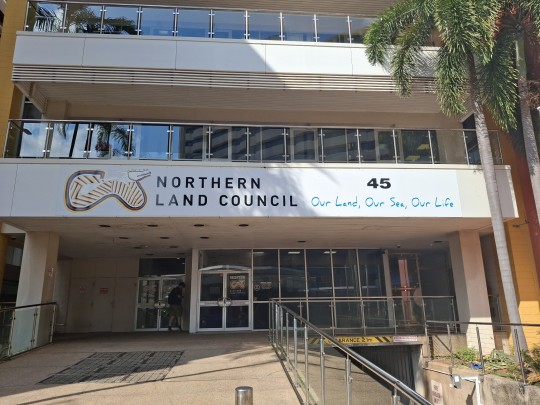



2 notes
·
View notes
Text
Best Escorted Tours of Australia: A Journey Like No Other
Australia, the land of contrasts and natural wonders, offers experiences unlike anywhere else in the world. From the sun-drenched beaches of the Gold Coast to the rugged outback of the Northern Territory, this vast country is a traveler’s paradise. But navigating such a large and diverse landscape can be overwhelming—especially for first-time visitors. That’s where the best escorted tours of Australia come in, offering curated, hassle-free, and enriching journeys across this spectacular continent.
Whether you’re looking to explore the iconic sights or discover hidden gems, escorted tours allow you to experience Australia with expert guides, comfortable accommodations, and well-planned itineraries. Here’s a detailed look at what makes these tours special and a roundup of the top options for different travel styles.
Why Choose an Escorted Tour in Australia?
1. Expert Guidance
Escorted tours come with knowledgeable tour guides who are not only well-versed in Australia’s history, culture, and geography but also provide local insights you won't find in guidebooks.
2. Convenience and Comfort
Forget about renting a car or navigating public transport in remote areas. Tours take care of everything—transportation, accommodation, meals, and entry to attractions.
3. Comprehensive Itineraries
Most escorted tours are designed to maximize your time. Whether you have a week or a month, the schedule ensures you see the highlights without feeling rushed.
4. Safety and Security
Australia’s wilderness is stunning, but parts of it can be remote and challenging to access. With a guided group, you can explore worry-free.
Top Escorted Tours of Australia
Here are some of the best escorted tours of Australia that cater to a variety of interests, from coastal escapades to outback adventures.
1. Grand Australian Adventure – AAT Kings
Duration: 15 days Regions Covered: Sydney, Melbourne, Great Barrier Reef, Alice Springs, Uluru, and more
This tour is perfect for travelers wanting a broad overview of Australia. Highlights include the Sydney Opera House, a snorkelling adventure on the Great Barrier Reef, and witnessing Uluru at sunset. With luxury coaches, high-end hotels, and seasoned guides, it’s an unforgettable journey.
2. Outback Explorer – Intrepid Travel
Duration: 10 days Regions Covered: Adelaide to Darwin via the Red Centre
If you're fascinated by Australia’s heartland, this tour is a must. It covers iconic sites like Coober Pedy (an opal-mining town), Kings Canyon, and Kakadu National Park. Intrepid keeps group sizes small, creating a more intimate and immersive experience.
3. East Coast Discovery – Trafalgar
Duration: 12 days Regions Covered: Brisbane, Fraser Island, Whitsundays, Cairns
This escorted tour explores the wonders of Australia’s East Coast. You’ll relax on the white sands of Fraser Island, sail through the Whitsundays, and visit the Daintree Rainforest. It’s ideal for nature lovers and beach enthusiasts.
4. Tasmania In-Depth – Inspiring Journeys
Duration: 7 days Regions Covered: Hobart, Cradle Mountain, Freycinet National Park
This boutique tour offers an in-depth exploration of Tasmania, Australia’s island state. It’s packed with nature walks, gourmet food experiences, and breathtaking coastal scenery. The intimate group size and luxurious accommodations make it one of the best escorted tours for mature or eco-conscious travelers.
5. Western Australia Explorer – APT Touring
Duration: 14 days Regions Covered: Perth, Margaret River, Broome, Kimberley
Western Australia is less-traveled but offers some of the country's most dramatic landscapes. From the wine country of Margaret River to the striking cliffs of the Kimberley, this escorted tour is designed for those wanting to see a different side of Australia.
What to Expect on an Escorted Tour
Comfortable Transportation
Most tours offer modern, air-conditioned coaches with panoramic windows. Some include train journeys like The Ghan or Spirit of Queensland for a unique perspective of the landscape.
Quality Accommodations
Whether it’s luxury hotels, charming lodges, or eco-resorts, escorted tours often partner with top-rated accommodations.
Cultural Immersion
Expect authentic cultural experiences such as Aboriginal cultural presentations, Aussie BBQ nights, and local farm visits.
Meal Inclusions
Many tours include daily breakfasts, selected lunches, and a few group dinners. This leaves you with enough freedom to explore local cuisine.
Leisure Time
While the itineraries are packed, you’ll also get downtime to relax, shop, or explore on your own.
Tips for Choosing the Best Escorted Tour
1. Know Your Travel Style
Are you adventurous or relaxed? Solo or with a partner? Choose a tour that matches your energy and preferences.
2. Read Reviews
Look for feedback on tour companies and specific packages. Sites like TripAdvisor or TourRadar offer real user experiences.
3. Check Group Size
Smaller groups offer a more personal experience, while larger groups can be more social and economical.
4. Inquire About Inclusions
Always clarify what’s included—meals, flights, park fees, and optional excursions—to avoid surprises.
5. Consider the Season
Australia’s climate varies dramatically. Northern regions are tropical, while the south has distinct seasons. Plan accordingly.
Best Time to Take an Escorted Tour in Australia
Summer (Dec–Feb): Ideal for Tasmania and southern regions, but can be too hot in the Outback.
Autumn (Mar–May): A pleasant season almost everywhere.
Winter (Jun–Aug): Great for the Northern Territory and Queensland.
Spring (Sep–Nov): Perfect for wildflower trails in Western Australia and coastal adventures.
Final Thoughts
Choosing one of the best escorted tours of Australia allows you to fully embrace the essence of this incredible country without the stress of planning every detail. Whether you’re captivated by vibrant cities, enchanted by natural wonders, or curious about Aboriginal culture, there’s a tour that’s right for you.
0 notes
Text
Darwin to Kakadu Day Trip vs. Overnight Tour: Which Suits You Best?
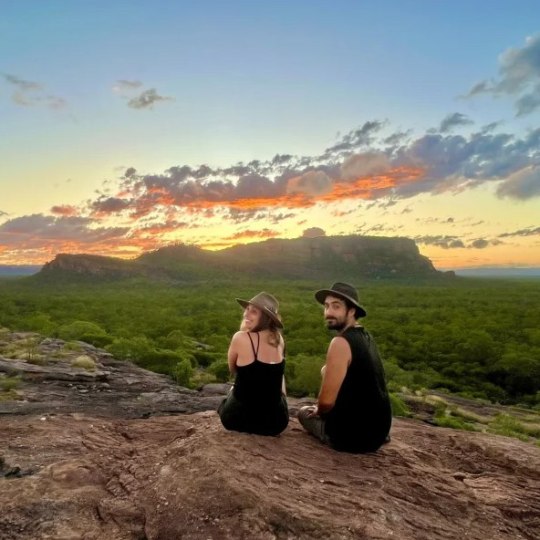
Exploring Kakadu National Park is an unforgettable journey, packed with stunning landscapes, rich Indigenous history, and a diversity of wildlife that’s hard to find anywhere else. But when planning a visit from Darwin, a question arises: should you opt for a quick Darwin to Kakadu day trip or dive deeper with an overnight tour? Here’s a breakdown of both options to help you decide which is the best fit for your adventure style.
The Darwin to Kakadu Day Trip: Quick and Efficient
If you’re short on time or looking for a glimpse of Kakadu’s highlights, a Kakadu Day Tour from Darwin is a fantastic choice. Starting early, you’ll journey from Darwin to Kakadu and enjoy a full day exploring the park’s most popular sites. Key stops usually include Ubirr Rock for ancient Aboriginal rock art, the tranquil Yellow Water Billabong, and scenic lookouts over lush wetlands.
A day trip is action-packed and efficient, giving you a taste of Kakadu’s beauty in just a few hours. However, with the limited time, there’s only so much ground you can cover. For travelers wanting a quick but rich experience, this option ticks all the boxes.
Pros of a Kakadu Day Trip:
Perfect for tight schedules or day-trippers.
Covers major sites and provides a snapshot of the park.
Guided tours offer plenty of information in a short time.
Cons of a Kakadu Day Trip:
Limited time at each location.
Early start and late return, making it a long day.
The Overnight Kakadu Tour: Dive Deeper
If you have more time, consider an overnight Kakadu National Park tour to immerse yourself in the landscape. An extended stay allows for a slower pace, with more time to explore hidden spots and experience a quieter side of the park after the day-trippers leave. In addition to the day-trip stops, you may visit Jim Jim Falls, Kakadu’s tallest waterfall, or take a night tour to witness the area’s unique nocturnal wildlife.
Overnight tours often include the chance to sleep under the stars or stay at a comfortable lodge, giving you the full Kakadu experience. With the luxury of time, you’ll be able to connect more deeply with Kakadu’s natural and cultural wonders.
Pros of an Overnight Tour:
More comprehensive coverage of the park’s attractions.
Flexible schedule allows for leisurely exploration.
Includes unique experiences like sunset views and evening activities.
Cons of an Overnight Tour:
Higher cost due to accommodations and extended services.
Requires more time, which may not fit everyone’s itinerary.
Which One Is Right for You?
If you’re a day-tripper or have limited time, the Darwin to Kakadu day trip is ideal. It’s efficient, hits the highlights, and gives you a taste of Kakadu’s beauty without committing multiple days. However, if you crave a deeper connection with the landscape, enjoy camping or staying in lodges, and want to see more than the highlights, an overnight Kakadu National Park tour is well worth the extra time.
Whether you choose a quick day tour or an immersive overnight stay, Kakadu offers an unforgettable escape into Australia’s wild beauty.
0 notes
Text
6 Surveying Challenges in Remote Australian Areas
6 Surveying Challenges in Remote Australian Areas
Surveying in remote areas of Australia is a complex and demanding task that requires overcoming a wide array of challenges. The country’s vast, diverse, and often unforgiving landscapes present unique obstacles, from extreme weather conditions and wildlife to logistical hurdles and cultural considerations. Surveyors Sydney professionals who working in these isolated regions must be prepared to adapt to the environment, work with limited resources, and ensure that their data remains accurate despite the difficulties.
In this article, we explore six of the most significant challenges surveyors face when working in remote Australian areas and provide insights into how these obstacles can be managed.
1. Accessibility and Logistics: Navigating the Outback
Perhaps the most obvious challenge when working in remote areas is simply getting to the survey site. Australia’s vast size means that many locations are far from major population centres, and access roads are often either non-existent or in poor condition. Surveyors may find themselves working in areas that can only be reached by off-road vehicles, helicopters, boats, or even on foot. In addition to the distances, other logistical factors, such as fuel availability, transportation for equipment, and supply chain management, must be carefully considered.
For example, surveyors working in remote areas like the Kimberley, Pilbara, or central Australia often need to travel for days to reach their sites. These regions may also have limited or no access to basic amenities such as fuel, water, or accommodation. A well-planned logistics strategy is vital to ensure that survey teams have everything they need to carry out their work.
Solution: Pre-survey planning is essential. Satellite imagery and mapping software can help identify the best routes and potential obstacles. Working with local authorities or landowners to arrange access is also critical. Transporting enough supplies, including water, fuel, and food, ensures that surveyors are self-sufficient once they arrive at the site. Survey teams should also invest in reliable off-road vehicles or helicopters, depending on the terrain, and have backup plans in case of road closures, equipment failure, or bad weather. 2. Harsh Environmental Conditions: Battling the Elements
Remote areas of Australia are known for their extreme weather conditions, which can range from the searing heat of the desert to torrential rains in tropical regions. The Outback, for example, is notorious for its blistering temperatures that can exceed 40°C (104°F) during summer, while northern regions like Cape York and Kakadu experience high humidity and monsoonal rains.
Surveyors must contend not only with heat but also with dust storms, strong winds, flash floods, and in some cases, the cold in higher altitudes or southern parts of the country. These harsh conditions make surveying physically demanding and can impact the accuracy of equipment due to environmental interference.
Solution: Preparing for extreme weather is key to success in remote areas. Surveyors should be equipped with proper clothing and gear, such as sun-protective hats, breathable long-sleeved shirts, hydration systems, and sunblock for protection against the sun. They should also carry weather-resistant equipment, and in regions prone to flooding or storms, it is important to have contingency plans for evacuation or delays. Monitoring local weather conditions and adjusting the survey schedule accordingly can help minimise risk. 3. Limited Communication and Connectivity: Operating in Isolation
Remote regions often lack the communication infrastructure found in more populated areas, such as mobile phone towers and reliable internet connections. This presents a significant challenge for surveyors, as modern surveying methods rely heavily on digital tools that require data transfer, GPS systems, and communication with headquarters. Without a stable connection, surveyors may find it difficult to upload data, receive real-time updates, or communicate with their teams in case of emergencies.
Furthermore, being cut off from communication networks can raise safety concerns, particularly in isolated areas where help may not be easily available in the event of an accident or equipment failure.
Solution: In areas with limited mobile coverage, satellite communication devices, handheld GPS units, and mobile hotspots are invaluable tools. These devices ensure that survey teams remain connected with colleagues and can access emergency services if necessary. Using two-way radios as a backup form of communication is also essential, particularly in situations where teams are spread across a wide area. Additionally, surveyors should prearrange check-ins and reporting schedules to minimise the risks associated with working in isolation. 4. Wildlife and Natural Hazards: Working with Nature
Australia’s remote regions are home to a variety of wildlife, some of which can pose threats to survey teams. Surveyors may encounter snakes, spiders, crocodiles, dingoes, or even large bird species like emus or cassowaries. Insects, including flies and mosquitoes, are also prevalent and can be a constant nuisance, especially in tropical areas. Natural hazards such as bushfires, flash floods, and landslides further complicate surveying tasks.
In northern Australia, surveyors may need to be cautious of crocodile-infested waters when working near rivers or coastlines. In desert regions, encounters with venomous snakes or aggressive dingoes may be a concern. Surveyors must also be mindful of their surroundings and prepared for sudden weather changes that can lead to hazardous situations like flash floods or bushfires.
Solution: Survey teams need to be trained in wildlife safety and how to respond to potential threats. Carrying first-aid kits, insect repellents, and snakebite kits is essential. When working in areas with dangerous animals, surveyors should follow local guidelines and best practices to avoid encounters. For instance, setting up camp away from water sources can reduce the risk of crocodile attacks. Additionally, monitoring fire and flood warnings through government alerts and being prepared to evacuate quickly can help surveyors stay safe. 5. Equipment Limitations: Ensuring Functionality in Remote Conditions
Surveying in remote areas requires the use of advanced technology, including drones, GPS systems, total stations, and other high-tech equipment. However, the harsh conditions of remote Australia can cause significant wear and tear on these tools. Dust, moisture, and extreme temperatures can interfere with equipment functionality, while the lack of electricity or charging facilities in isolated areas means surveyors must be careful about power usage.
High-tech equipment may also face connectivity issues, especially when relying on satellite signals in remote areas. In cases where technology fails, surveyors may need to revert to traditional methods, such as manual measurements or using compasses.
Solution: Survey teams should invest in durable, rugged equipment designed for harsh environments. Portable solar panels, extra batteries, and backup power supplies are essential for keeping equipment operational in areas without electricity. Additionally, surveyors should be prepared to maintain and clean their tools regularly to prevent damage from dust or moisture. Carrying backup tools, such as manual compasses or traditional theodolites, ensures that work can continue even if high-tech equipment fails. 6. Cultural and Land Rights Considerations: Respecting Indigenous Communities
Many remote areas in Australia are located on Indigenous land, and surveyors must respect the cultural and legal requirements associated with working on these lands. Indigenous communities often have strong connections to their land, and certain areas may be sacred or restricted for cultural reasons. Surveyors must seek permission from local Indigenous authorities before conducting work and must also be mindful of Indigenous customs and laws.
Failure to engage with Indigenous communities can result in delays, legal challenges, or conflicts. Surveyors must navigate these complex relationships with care, ensuring that their work is both culturally sensitive and legally compliant.
Solution: Building relationships with Indigenous communities and understanding local cultural practices is crucial for working in remote areas. Survey teams should engage with Indigenous land councils or local elders early in the planning process to seek permission and ensure that their work aligns with local customs. Involving local Indigenous guides or consultants in the surveying process can also provide valuable insights and ensure smoother operations.
Surveying in remote Australian areas requires a combination of advanced planning, adaptability, and respect for both the environment and local cultures. From logistical challenges and extreme weather to wildlife hazards and equipment limitations, surveyors must be prepared to tackle a wide range of obstacles. By implementing effective strategies for each of these challenges, survey teams can conduct their work efficiently and safely, ensuring accurate results in even the most isolated regions of the country.
The key to success lies in thorough preparation, investing in reliable technology, and fostering positive relationships with Indigenous communities. With these tools in hand, surveyors can rise to the challenges of working in remote Australia and deliver valuable insights for development, land management, and conservation efforts across the continent.
0 notes
Text
Explore and Thrive: Vacation Care Camps in Australia
Australia's diverse landscapes and vibrant culture offer an ideal backdrop for unforgettable summer adventures, especially for children looking to explore, learn, and make lasting memories. Vacation care camps across the country provide a unique opportunity for kids to engage in a range of enriching activities while fostering independence, teamwork, and personal growth. In this blog post, we'll delve into the benefits of vacation care camps in Australia, highlight popular destinations and activities, and provide tips for selecting the right camp for your child.
Why Choose Vacation Care Camps in Australia?
Vacation care camps offer numerous benefits that go beyond traditional childcare, including:
Outdoor Exploration: Opportunities to explore Australia's natural beauty through camping, hiking, and outdoor adventures.
Skill Development: Activities that promote teamwork, leadership, and resilience in a supportive and structured environment.
Cultural Immersion: Experiencing Aboriginal culture, local traditions, and historical sites unique to Australia.
Personal Growth: Building confidence, independence, and self-esteem through new experiences and challenges.
Popular Destinations and Activities
Bush Camps:
Location: Remote bush settings across Australia, such as the Blue Mountains, Kakadu National Park, or the Grampians.
Activities: Bushwalking, wildlife spotting, campfire storytelling, and learning survival skills.
Beach Camps:
Location: Coastal regions like the Gold Coast, Byron Bay, or the Great Barrier Reef.
Activities: Surfing lessons, snorkeling, beach games, and environmental conservation projects.
Adventure Camps:
Location: Adventure parks and outdoor education centers in Victoria, Queensland, and New South Wales.
Activities: High ropes courses, rock climbing, kayaking, and team-building challenges.
Cultural Camps:
Location: Cultural centers and heritage sites across Australia, including Indigenous-owned enterprises.
Activities: Aboriginal art workshops, storytelling, traditional dances, and learning about Indigenous history and customs.
Educational Camps:
Location: Educational institutions and environmental research centers nationwide.
Activities: Science experiments, nature studies, wildlife conservation programs, and sustainability workshops.
Tips for Choosing the Right Vacation Care Camp
Program Focus: Consider your child's interests and preferences when selecting a camp that offers activities aligned with their hobbies or learning goals.
Accreditation and Safety: Choose camps accredited by relevant authorities and ensure they adhere to safety standards and child protection policies.
Staff Qualifications: Verify that camp counselors and instructors are qualified, experienced, and trained in childcare and outdoor education.
Facilities and Amenities: Check the camp's facilities, accommodation options, meal plans, and accessibility to ensure a comfortable and enjoyable experience.
Reviews and Recommendations: Read reviews from other parents or seek recommendations from friends and family who have attended the camp.
Making the Most of Your Child's Camp Experience
Prepare Ahead: Pack essentials like sunscreen, insect repellent, comfortable clothing, and any necessary medications.
Encourage Independence: Support your child in embracing new experiences, making friends, and taking on challenges with confidence.
Stay Connected: Stay informed about camp activities and communicate with camp staff to address any questions or concerns.
Reflect and Share: Discuss your child's experiences and accomplishments at camp, encouraging them to share stories and memories with family and friends.
Conclusion
Vacation care camps in Australia provide an enriching and memorable experience for children, offering a blend of adventure, education, and personal development in unique natural and cultural settings. Whether exploring the outback, surfing the waves, or immersing in Aboriginal traditions, these camps create opportunities for children to grow, learn, and thrive during their school breaks.
Our dedicated team of Academy of Early Education caring educators is committed to unlocking the full potential of every child, guiding them on a journey of exploration and discovery. With a perfect blend of structured activities and creative play, we encourage children to develop critical skills while having fun and building lasting friendships.
#vacation care#vacation care camp australia#vacation care activities#vacation care for 12 year olds#sydenham childcare
0 notes
Photo
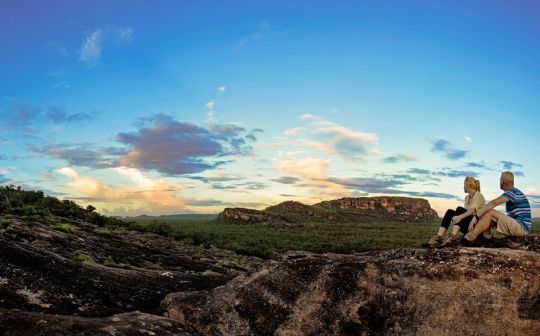
Kakadu Tourism launches new product, tours, Indigenous experiences and accommodation for 2024 season
0 notes
Text
Exploring Australia in Winter: A Comprehensive Guide to Your Adventure Down Under

As winter casts its chilly spell across much of the Northern Hemisphere, travelers often seek warmer destinations for a reprieve from the cold. Australia, with its diverse landscapes and unique experiences, beckons adventurers even during its winter season. From bustling cities to serene countryside, there's something for every traveler to discover in the Land Down Under during this time of the year.
Before embarking on your journey to Australia, thorough preparation is essential. Firstly, ensure you have all the necessary documents in order. For international travelers, obtaining a visa is a prerequisite for entry into Australia. Depending on your nationality, you may be eligible for different types of visas, such as tourist visas or working holiday visas. Be sure to check the Australian Government's Department of Home Affairs website for detailed information on visa requirements and the application process. Additionally, don't forget to secure travel insurance to cover any unforeseen circumstances during your trip.
Once your documents are sorted, it's time to plan your itinerary. Australia boasts a myriad of attractions, ranging from iconic landmarks to hidden gems. In winter, cities like Sydney, Melbourne, and Brisbane offer vibrant cultural scenes, delicious cuisine, and stunning architecture. Don't miss out on exploring the bustling streets of Melbourne's laneways or taking in the breathtaking views from Sydney's Harbour Bridge.
Venturing beyond the city limits, Australia's small towns and countryside reveal a different side of the country's charm. From the picturesque landscapes of the Yarra Valley to the rugged beauty of the Blue Mountains, there's no shortage of scenic wonders to behold. Consider renting a car or camper van to embark on a road trip through the countryside, where you can soak in the tranquil beauty of Australia's natural landscapes at your own pace.
For those seeking adventure off the beaten path, Australia offers plenty of opportunities for off-roading and long-distance biking. Whether you're exploring the rugged terrain of the Outback or tackling the scenic coastal trails, be sure to come prepared with proper gear and equipment. International visitors can obtain an International Driving Permit australia (IDP) before arriving in Australia, which allows them to legally drive a vehicle or motorcycle in the country. Remember to familiarize yourself with Australian traffic rules and regulations to ensure a safe and enjoyable journey.
Accommodation options in Australia cater to every budget and preference. Budget-conscious travelers can explore options such as couch surfing, hostels, or budget hotels for affordable lodging. Websites and apps like Couchsurfing and Hostelworld are valuable resources for finding inexpensive accommodation options across the country. Alternatively, for a more comfortable stay, consider booking a holiday rental or boutique hotel in one of Australia's charming towns or coastal villages.
For outdoor enthusiasts, Australia's vast wilderness offers endless opportunities for hiking, camping, and adventure. National parks such as Kakadu, Tasmania, and the Grampians boast scenic trails and breathtaking vistas, perfect for hiking and solo camping. Before embarking on any outdoor excursion, be sure to check park regulations and obtain any necessary permits or passes.
If you're planning to explore Australia by vehicle, renting a car or motorbike is a convenient option for independent travel. International visitors can apply for an International Driving Permit (IDP) online through their home country's automobile association. This permit, along with a valid driver's license from your home country, allows you to legally drive in Australia for a specified period.
In conclusion, winter in Australia presents a unique opportunity to explore the country's diverse landscapes and vibrant culture. From bustling cities to remote wilderness, there's no shortage of adventures waiting to be discovered. By adequately preparing for your journey and embracing the spirit of exploration, your winter escapade in Australia is sure to be an unforgettable experience.
In this article, we've covered essential aspects such as visa requirements, transportation options, accommodation choices, and outdoor activities, providing you with all the information you need to plan your winter adventure in Australia. So pack your bags, hit the road, and get ready to explore the wonders of the Land Down Under!
0 notes
Text
Exploring Kimberley: The Ultimate Guided Tour Experience
Are you ready to embark on a journey to one of Australia's most stunning destinations? Kimberley, with its rugged landscapes, ancient gorges, and breathtaking coastlines, offers an unforgettable adventure for travellers seeking a taste of the wild. But to truly make the most of your trip, consider opting for guided tours.
In this blog post, we'll dive deep into why book kakadu tours are the way to go and what you can expect from an ultimate adventure.
Why Choose Guided Tours to Kimberley?
When you're planning a trip to Kimberley, you might wonder whether to go it alone or join a guided tour. Here's why the latter is the preferred choice for many:
Expertise: Knowledgeable guides are your keys to unlocking Kimberley's hidden gems. They know the terrain, wildlife, and culture inside out, ensuring you don't miss a thing.
Safety: Kimberley's remote locations can be challenging to navigate. With a guide by your side, you can explore with confidence, knowing you're in capable hands.
Local Insights: Guides share their deep understanding of the region's history, traditions, and ecological importance, adding depth to your journey.
What to Expect on a Guided Tour?
Now that you're convinced about the benefits let's delve into what you can expect from guided tours:
Scenic Wonders
Bask in the beauty of the Bungle Bungle Range, a UNESCO World Heritage-listed site with beehive-shaped domes that will leave you speechless.
Your adventure begins with awe-inspiring landscapes. Be prepared to witness rugged cliffs, waterfalls, and vast, untouched wilderness.
Wildlife Encounters
With an expert guide, you'll have the best chances of spotting these creatures in their natural habitat.
Kimberley is a haven for wildlife enthusiasts. Kangaroos, wallabies, crocodiles, and a plethora of bird species call this region home.
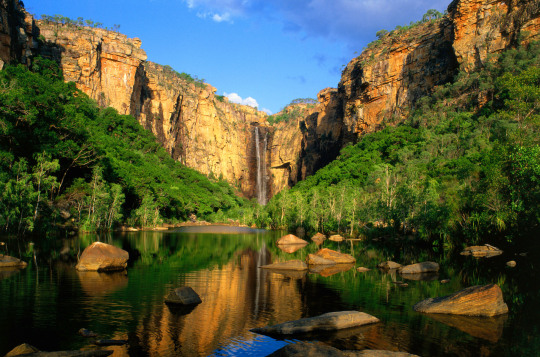
Cultural Immersion
Guided tours often include visits to Aboriginal communities, where you can connect with locals and gain a deeper appreciation for their way of life.
Engage with the rich indigenous culture of Kimberley. Learn about Dreamtime stories, traditional hunting techniques, and the significance of ancient rock art.
Adventure Activities
Your guide will ensure your safety while you experience these heart-pounding activities.
If you crave adventure, Kimberley has it all. From thrilling helicopter rides over the Mitchell Falls to cruising along the dramatic coastline, there's something for every adrenaline junkie.
Stress-Free Travel
Forget about the hassles of planning, navigating, and making reservations. Guided tours handle all the logistics, allowing you to relax and enjoy your journey.
Accommodations, meals, and transportation are all taken care of, leaving you with more time to savour the experience.
Choosing the Right Guided Tour
Not all guided tours to Kimberley are created equal. To make the most of your adventure, consider the following tips when selecting your tour:
Group Size: Smaller groups often provide a more intimate experience. Look for tours that limit the number of participants.
Duration: Decide how long you want to immerse yourself in Kimberley's beauty. Tours can vary from a few days to several weeks.
Inclusions: Check what's included in the tour package. Some tours offer additional activities or cultural experiences.
Reviews: Reading reviews from previous travellers can help you gauge the quality of a tour operator.
Conclusion
If you're dreaming of exploring stunning landscapes, encountering unique wildlife, and immersing yourself in the rich culture of Kimberley, then opting for guided tours to Kimberley is the way to go. With knowledgeable guides, safety, and an array of activities at your fingertips, your Kimberley adventure will be an unforgettable journey into the heart of Australia's wilderness.
Don't miss out on this opportunity to create lasting memories in one of the world's most awe-inspiring destinations. Book your guided tour today and get ready for the adventure of a lifetime!
Source: Exploring Kimberley: The Ultimate Guided Tour Experience
0 notes
Text
Australia Unveiled: Handpicked Tour Packages to Create Lasting Memories
Are you an adventurous soul seeking to explore the beauty and wonders of Australia? Look no further! Our meticulously crafted Australia tour packages offer an unforgettable journey through this mesmerizing land of contrasts. From the sun-kissed beaches to the rugged Outback, from vibrant cities to serene natural landscapes, our handpicked tour packages are designed to immerse you in the diverse tapestry of Australia's attractions.

Discovering the Essence of Australia Through Thoughtfully Curated Tour Packages
Our Australia tour packages are more than just vacations; they are gateways to experiences that will be etched in your memories forever. Each package has been thoughtfully crafted to offer you a unique perspective on the essence of Australia. Whether you're a nature enthusiast, an adventure seeker, a wildlife lover, or a culture aficionado, our diverse range of tour packages caters to every preference.
1. Coastal Wonders: Beach Bliss and Beyond
Embark on a journey along Australia's breathtaking coastline with our Coastal Wonders package. Immerse yourself in the crystal-clear waters of the Great Barrier Reef, relax on the iconic Bondi Beach, and witness the stunning coastal cliffs along the Great Ocean Road. This package is a paradise for beach lovers and offers a chance to explore marine life like never before.
2. Outback Odyssey: A Desert Adventure
For those craving an off-the-beaten-path experience, our Outback Odyssey package is tailor-made. Traverse the vast expanse of the Australian Outback, where rugged terrains and ancient landscapes will leave you in awe. From the iconic Uluru-Kata Tjuta National Park to the unique wildlife of Kangaroo Island, this package is a journey into the heart and soul of Australia's interior.
3. Urban Escapade: Discover Vibrant Cities
Australia's cities are pulsating with life, culture, and diversity. Our Urban Escapade package lets you explore the iconic landmarks of Sydney, the artistic vibes of Melbourne, and the laid-back charm of Brisbane. Discover the fusion of modernity and tradition as you stroll through bustling markets, indulge in gourmet delights, and immerse yourself in local art scenes.
4. Wilderness Retreat: Nature at Its Best
If you seek tranquility and a deep connection with nature, our Wilderness Retreat package is your ideal choice. Explore the lush rainforests of the Daintree, hike through the pristine Tasmanian wilderness, and cruise through the serene Murray River. This package offers a rejuvenating escape from the urban bustle, allowing you to unwind amidst Australia's natural wonders.
5. Cultural Immerse: Aboriginal Heritage Experience
Delve into Australia's rich indigenous heritage with our Cultural Immerse package. Engage with Aboriginal communities, learn about ancient traditions, and witness captivating performances that showcase the world's oldest living cultures. From the sacred sites of Kakadu National Park to the art-filled streets of Alice Springs, this package celebrates Australia's diverse cultural tapestry.
Crafting Lasting Memories with Australia Tour Packages
No matter which package you choose, our Australia tour packages are designed to create lasting memories. We understand that every traveler is unique, and our aim is to cater to your preferences while ensuring you experience the best that Australia has to offer. From accommodations that blend luxury and comfort to guided experiences that provide insights into local life, our packages cover every detail.
So, why wait? Embark on an unforgettable journey through the stunning landscapes and captivating experiences that Australia has in store. Book your dream Australia tour package with us today and let the adventure begin! Australia awaits, ready to unveil its treasures and create memories that will last a lifetime.
Australia tour packages offer a gateway to unparalleled experiences across this vast and diverse country. From the golden beaches to the rugged outback, from bustling cities to serene natural landscapes, these handpicked packages cater to a variety of interests and preferences. By choosing one of these thoughtfully curated packages, you're not just embarking on a vacation; you're embarking on a journey that will create lasting memories of the breathtaking beauty and unique culture of Australia. Book your Australia tour package today and get ready for an adventure of a lifetime.
Must Read : Embark on a Journey through Europe: Exclusive Trip Packages for Your Dream Vacation
0 notes
Text
Immerse Yourself in the Magic of Australia: Unforgettable Tour Packages
Australia, the land down under, is a breathtaking destination that offers a wealth of natural wonders, vibrant cities, and a rich indigenous culture. From stunning coastlines to sprawling deserts, lush rainforests to iconic landmarks, Australia has it all. If you're ready for an unforgettable adventure, look no further than the enticing Australia tour packages that will immerse you in the magic of this incredible country. In this article, we'll explore the diverse experiences and attractions that await you in Australia, highlighting the best tour packages available.

Discover the Diversity of Australia:
Australia is a vast and diverse country, offering something for every traveler. Whether you're a nature enthusiast, a history buff, or a city explorer, there are tour packages tailored to suit your interests. Let's delve into the various facets of Australia that make it a truly enchanting destination.
Captivating Cities:
Start your journey in the vibrant city of Sydney, with its iconic landmarks like the Sydney Opera House and the Harbour Bridge. Explore the cultural melting pot of Melbourne, renowned for its art, food, and coffee scene. Head north to Queensland's Gold Coast, where stunning beaches and thrilling theme parks await. Each city has its unique charm, and tour packages often include guided city tours to ensure you don't miss the must-see attractions.
Natural Marvels:
Australia's natural beauty is unparalleled, and there are tour packages that showcase its breathtaking landscapes. Visit the Great Barrier Reef, a UNESCO World Heritage site, to witness the vibrant underwater world teeming with marine life. Journey to the heart of the Red Centre and witness the awe-inspiring Uluru (Ayers Rock) and Kata Tjuta (The Olgas). Don't forget to explore the ancient Daintree Rainforest in Queensland or hike the picturesque Blue Mountains in New South Wales. These tour packages offer an opportunity to connect with nature like never before.
Unique Wildlife:
Australia is home to some of the most unique and fascinating wildlife on the planet. With tour packages, you can get up close and personal with cuddly koalas, playful kangaroos, and the elusive platypus. Explore Kangaroo Island in South Australia or embark on a wildlife safari in Tasmania to witness these incredible creatures in their natural habitat.
Cultural Experiences:
Australia's indigenous culture is deeply rooted in its history and landscapes. Experience the ancient traditions, art, and storytelling of the Aboriginal and Torres Strait Islander peoples through immersive cultural tours. Discover ancient rock art in Kakadu National Park, learn the didgeridoo in Alice Springs, or join a guided walk with a local indigenous guide at Uluru. These tour packages offer a unique opportunity to gain insights into Australia's rich heritage.
Choosing the Right Australia Tour Package:
When selecting an Australia tour package, consider the duration, destinations, inclusions, and budget. Look for packages that align with your interests and preferences. Some may focus on specific regions, such as the East Coast or the Outback, while others offer comprehensive itineraries covering multiple states. Ensure that the package includes transportation, accommodation, guided tours, and ample free time for independent exploration.
Australia is a land of wonders, a destination that captivates the hearts of travelers from all around the globe. With its diverse landscapes, iconic landmarks, unique wildlife, and rich cultural heritage, it offers an unforgettable experience for every adventurer. The Australia tour packages available cater to a wide range of interests, ensuring that you can immerse yourself in the magic of this incredible country. So, pack your bags, get ready for an extraordinary journey, and let Australia weave its spell on you.
Must Read: Discover Europe: Customizable Tour Packages for Indians
0 notes
Text
The ultimate Darwin city guide - Australian Traveller

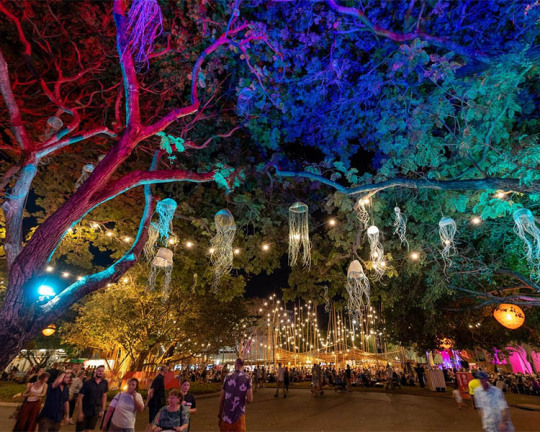

#Pee Wee’s#Vibe Hotel#Oaks Elan#Kakadu National Park#Crocosaurus Cove#darvin#australia#trip#trips#travel#travels#guide#cities#restaurant#food#hotel#hotels#accommodation#Darwin
0 notes
Text
Once a jolly swagman camped by a billabong....
After dropping the Chrises at Sydney Departures to catch their flight back to the UK (see previous blog post for part 1!), I headed onwards to the Domestic terminal to catch a flight up to Darwin. Arriving at 1am, I had a rather sleepless few hours on the floor of Darwin airport before greeting my parents through arrivals at 5am! We had 3 weeks of Outback adventures ahead to catch up on all we’d missed from a year apart!
We picked up our Britz campervan for the first part of the trip and headed straight in the direction of Kakadu National Park on the red dirt roads in the very hot sunshine to get straight into holiday mode! The evening was spent at an old aboriginal site called Ubirr; here there were ancient ochre paintings, beautiful rock formations and stunning vistas, perfect for a sunset viewing!
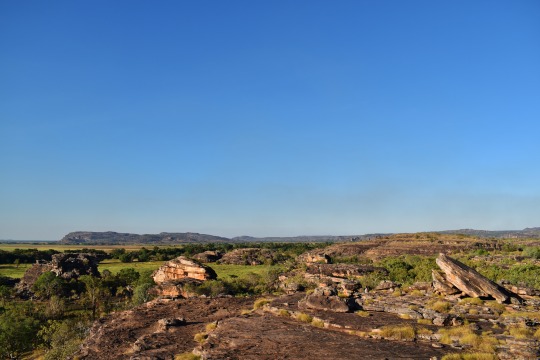
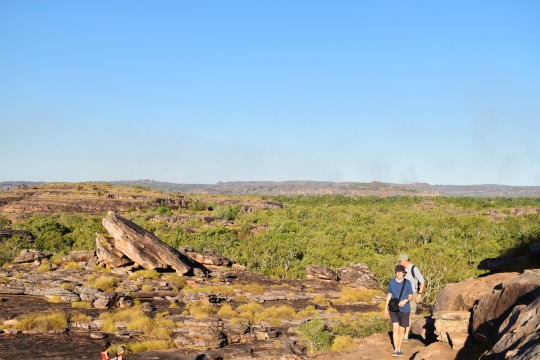
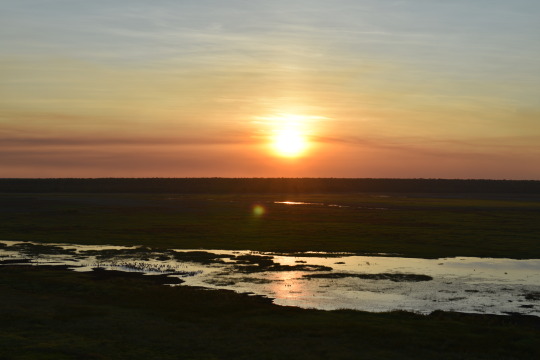
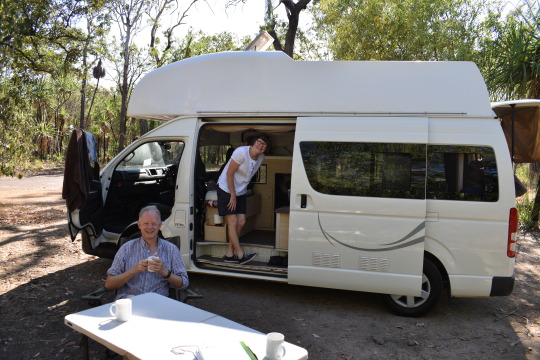
We’d heard there might be a possibility of seeing crocs in Kakadu although none of us were convinced we actually would. However, a stroll to Cahill’s Crossing proved us all wrong; on arrival we could see the ominous backs of about 12 crocodiles swimming around in the inaccurately named ‘East Alligator River’. There were locals fishing in the river standing scarily close to the edge, given that behind them were multiple collections of flowers and crosses commemorating people who had been killed in recent years by getting just that bit too close! It was incredible to see the crocodiles climbing out of the water and watching their size triple from what it had appeared in the water!

All those black dots in the water? Crocodiles!

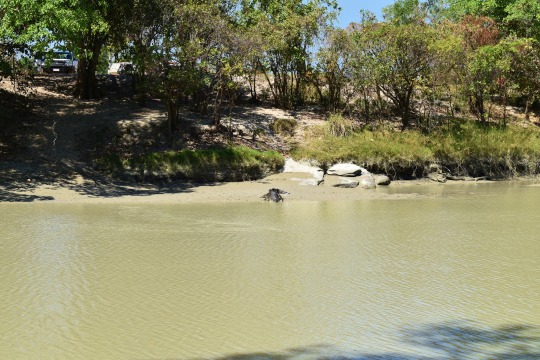
A stunning walk around Bardedjilidgi sandstone outcrops and a steep hike up to Nawlandja lookout overlooking the Nourlangie escarpment provided some of our first exposures to the incredible Kakadu landscape! Given how much land was burning all the time (at one point there were embers right up to the road we were driving along), we were surprised at how green the landscape was.
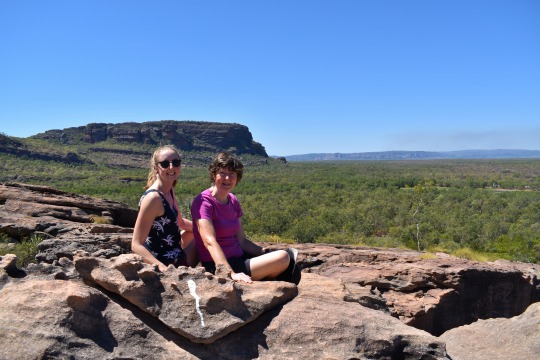
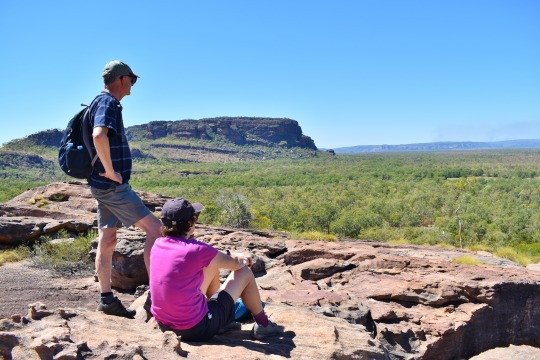

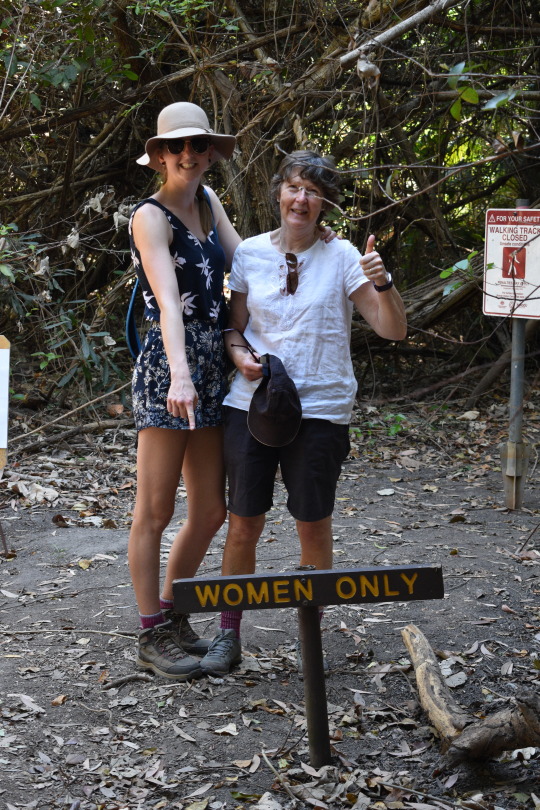
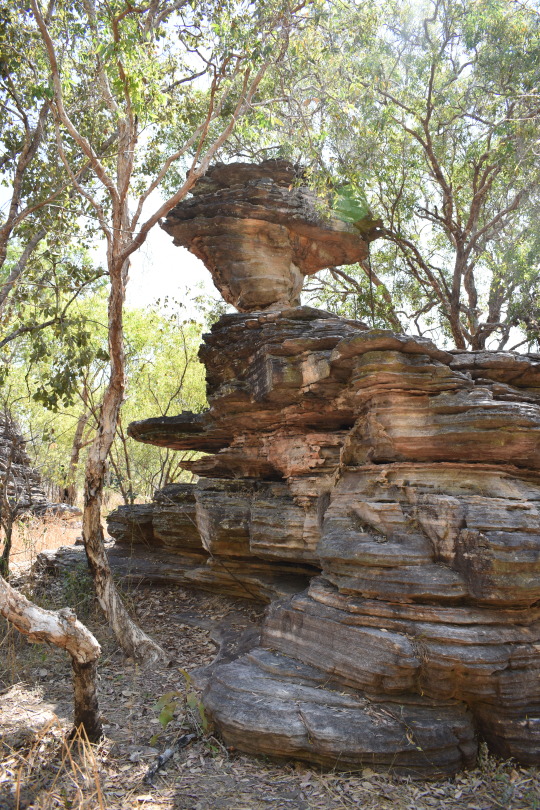
We braved another close croc encounter on a walk around Anbangbang billabong and also spotted our first Jabiru! It looked absolutely enormous – especially in comparison to all the other birds on the billabong!

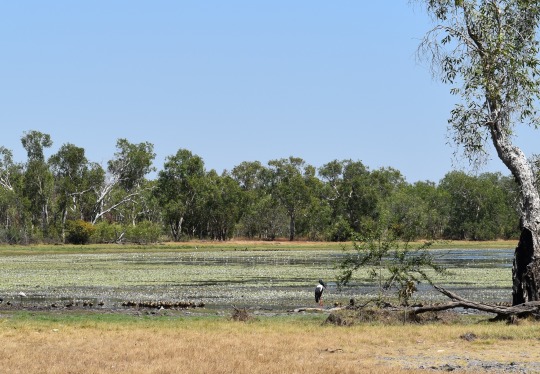
Spent the night at an unexpectedly beautiful campsite on the Mary River where we were surrounded by wallabies and kangaroos!
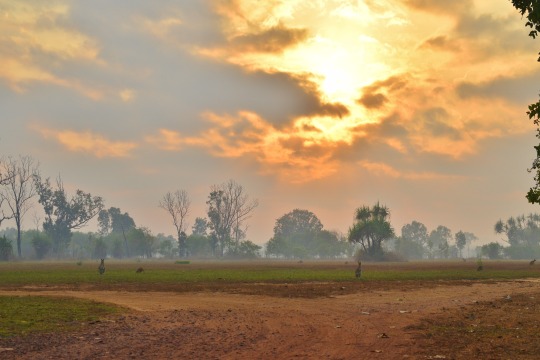

It was time to head across to Litchfield National Park – a smaller area and surprisingly quite different landscape to Kakadu given its relative proximity. We stopped off en route at the ‘magnetic termite mounds’ – so called as they are aligned with their main axis running north to south and orientated such to minimise midday sun exposure and warmth inside the mound. There were also some enormous mounds- up to 5 metres high!
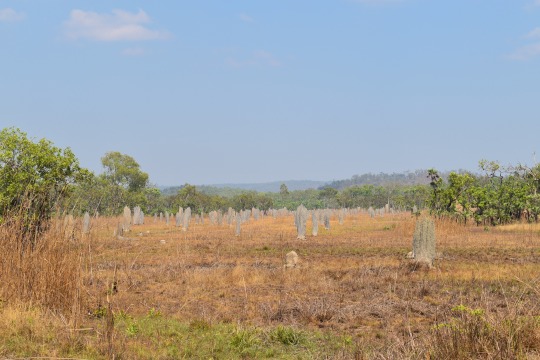
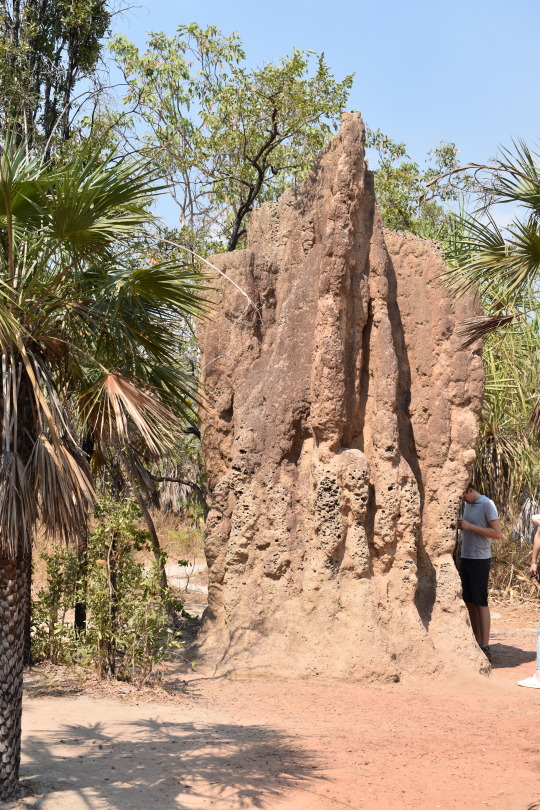
We did a walk to Buley rockholes (which themselves were full of people swimming) but we found our own private one just a few minutes downstream to have a much-needed refreshing dip! Our walk took us down to the popular Florence Falls, and then onwards to the stunning Wangi Falls where we were staying the night! Wangi falls had been closed until the week prior due to crocodile sightings so it was safe to say my mum did not look one bit relaxed for the beautiful sunset swim in there!
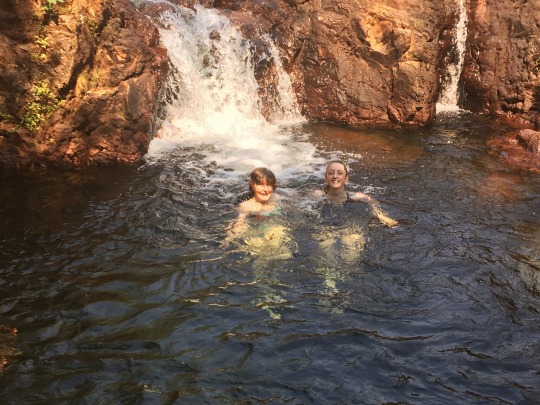
Buley Rockholes
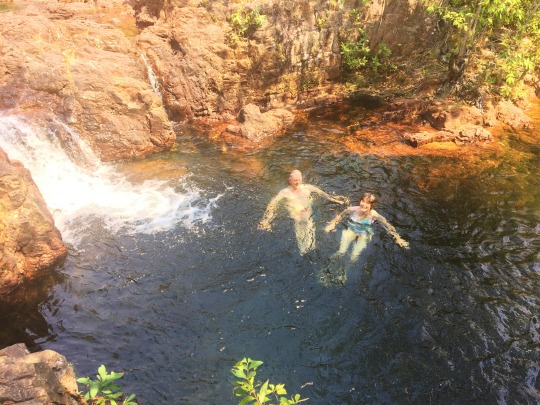

Wangi Falls
We squeezed as many hikes as we could in our short time in Litchfield so our last full day there was spent hiking along the Upper and Lower Cascades (literally clambering down a waterfall). It was so hot and we found an inviting rockhole mid-hike but had left our swimmers in the van– my dad and I are not ones to miss out on a plunge pool swimming opportunity so we just jumped in in our clothes! Lunch was at the top of yet another waterfall amid the Tjaetaba walk through a sharp contrast of monsoon forest and savanna landscapes! We finished the day with a walk around the Tolmer falls which were worth our close shave with heat stroke in the high temperatures of the afternoon!
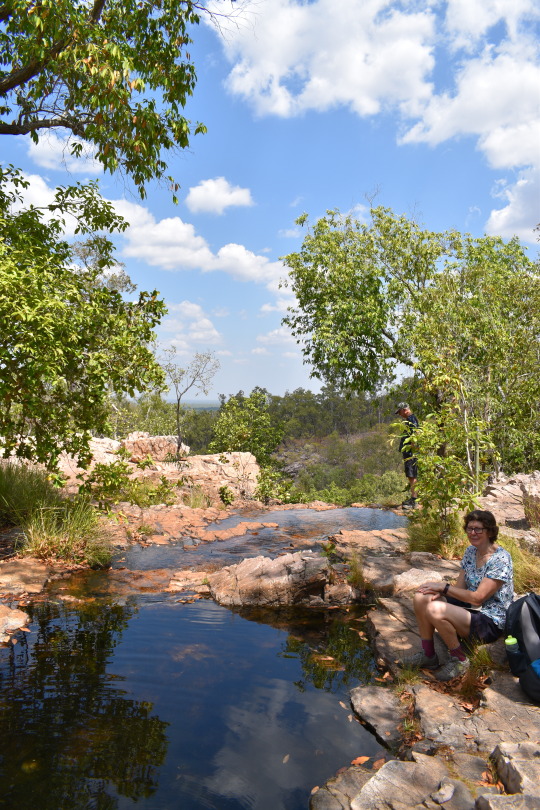

We briefly explored Darwin town centre and harbour before driving to the airport for our flight to Alice Springs for our Red Centre adventure!
Flying in we could see no evidence of any human life anywhere close until we got off the plane and saw there was in fact an airport there! It had just been expanses of red dirt as far as the eye could see, with no town in sight! We were staying in an amazing ‘glamping hut’ I found on Airbnb called Under The Hump. Sitting outside by the firepit having our kanga steaks with a beautiful view of the stars will certainly be one of me lasting memories of Alice! We weren’t quite prepared for the cold weather we would be faced with though – going from 32 degree mornings to 3 degrees was a bit of a shock to the system!
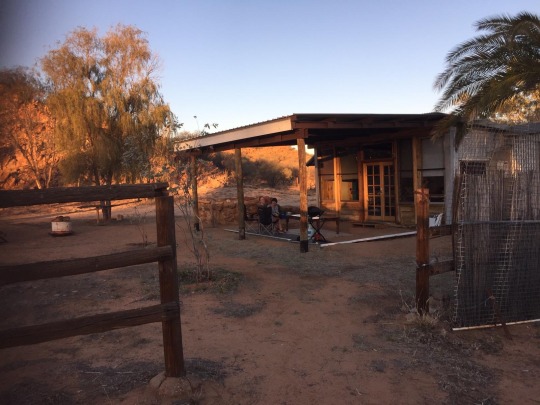
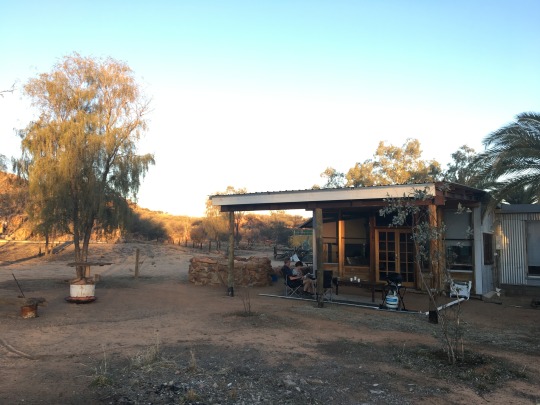
We explored the town and rather fell in love with its character! A small sleepy town surrounded thousands of miles of desert! Having lived by the coast all our life we realised it was the furthest any of us had ever been from the sea!
We explored the famous Todd Mall markets, and went to the Todd River (I was hugely disappointed by this as was expecting an actual river and was met by an expanse of sand. Apparently I was the only one to not be aware that this would be the case. My Tripadvisor review would be a generous 1star as far as rivers go. Same goes for the actual Alice Spring which I didn’t realise we had even seen until I was told later – because it was again just sand.) We spent a fascinating few hours at the National Women’s Pioneer Museum at the old gaol and a visit to the Telegraph station which allowed telegraphs to be sent between Adelaide and Darwin and was the site of the first European settlement in Central Australia (I imagine the Spring actually had water in it at that time….) – although should be acknowledged that the Arrernte people have inhabited what is now Alice Springs for thousands of years prior!

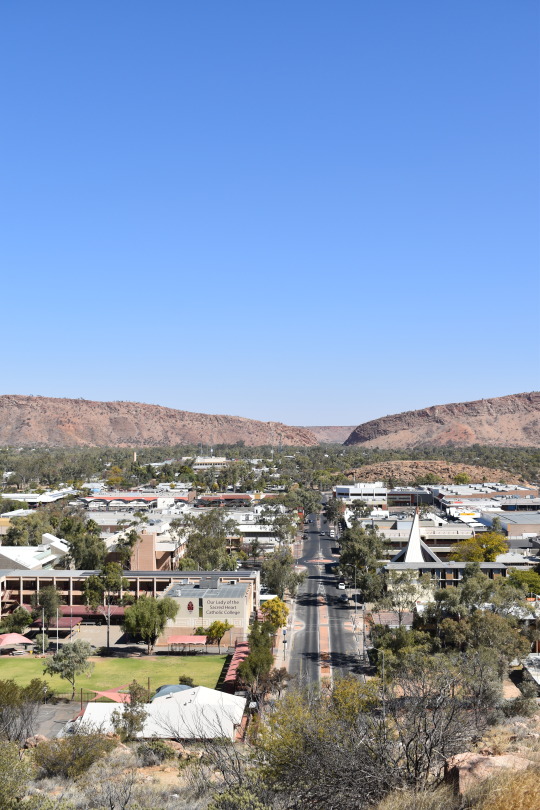
One of my favourite days of the trip was exploring the absolutely breath-takingly beautiful West MacDonnell ranges along the Larapinta trail. We started about 2 hours from Alice at our furthest point, Glen Helen Gorge. It was a deceivingly cold day despite the basking sunshine so we passed on taking the ‘refreshing dip’ here and felt for the many people we saw running who were doing a 4 day Larapinta trail run!

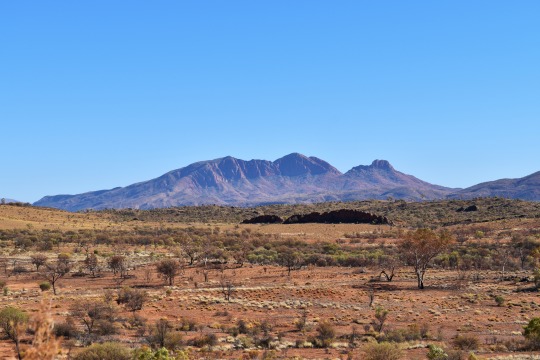
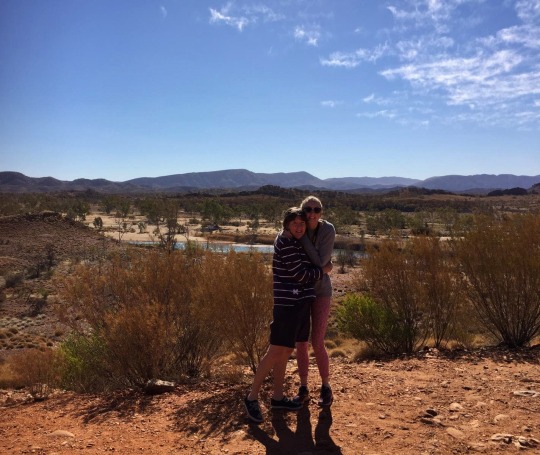
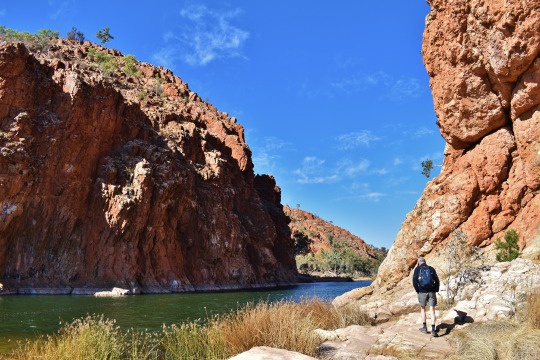
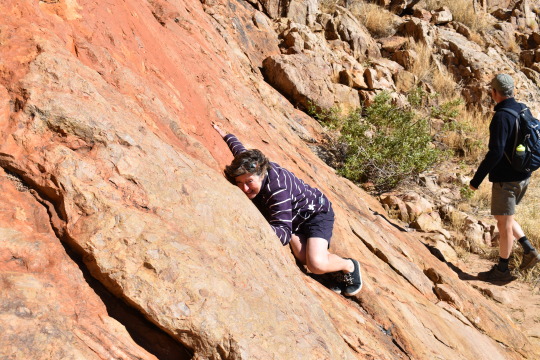
Mum trying to protect herself from the cold wind!
The next stop was the stunning Ormiston Gorge with hike around the top and through the middle of the gorge (which again had no water because dry season!). The other stops along the way are probably best described with photos rather than words. They included the Ochre pits where indigenous people collected ochre to use for rock and body paintings, which they used to tell Dreamtime stories and in ceremony; Serpentine Gorge with a steep hike up to a lookout over the West MacDonnells; Ellery Creek Hole and Simpsons Gap. We had hoped to see a few rock wallabies along the way but unfortunately they may have been hiding away from the cold!
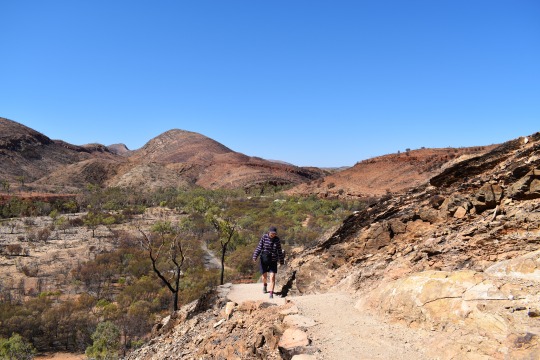


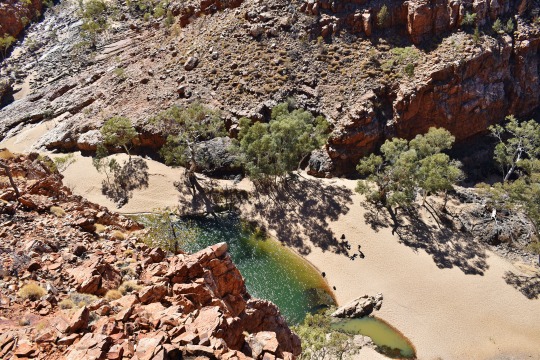
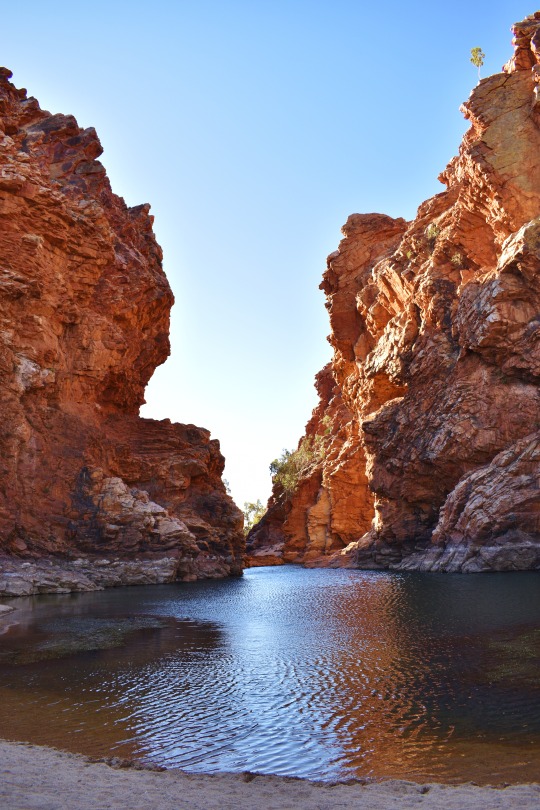
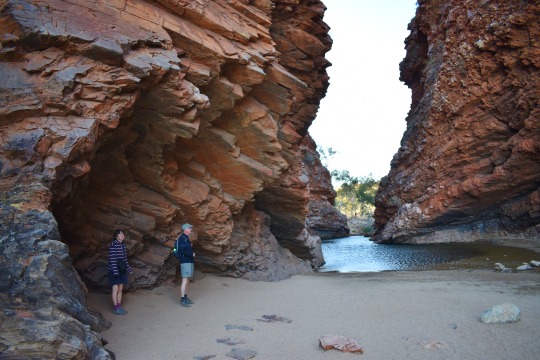

It was a long 5 hour drive down to Yulara (the small resort town for Uluru). 5 hours along a straight road with fairly barren red dirt desert either side; even just this relatively short distance made us appreciate how enormous and sparse this country is. We caught our first glimpse of Uluru and Kata Tjuta from afar as we approached and what a beautiful sight it was! We found a viewing area next to our accommodation where we watched our first of many Uluru sunsets!
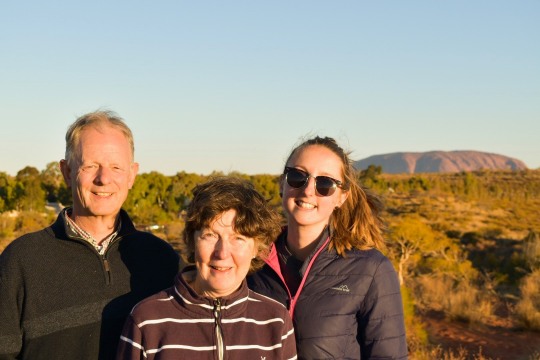
We spent the next 3 days exploring the National Park, learning about the significance of Uluru to the Anangu people and all about the local culture and traditions. Seeing Uluru up close was much more impressive than I'd imagined; what looks like a fairly uniform rock from far away is made of up so many caves and gorges and rock formations which all have cultural significance and stories behind them!

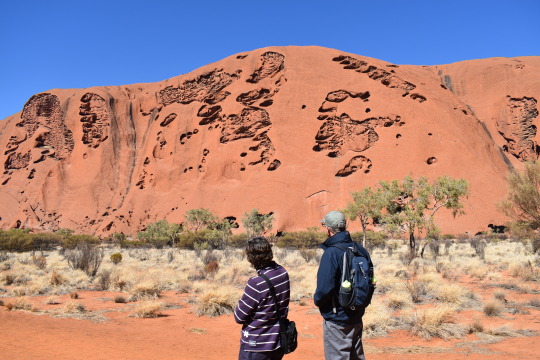
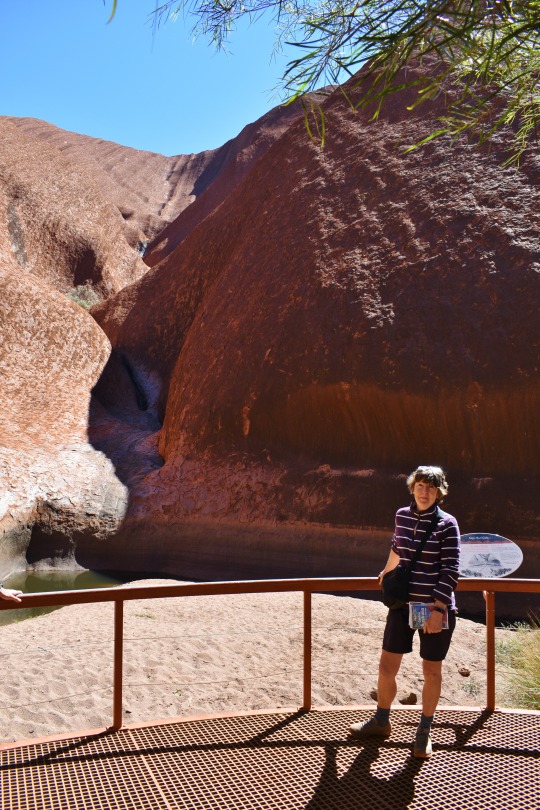
Mutitjulu Waterhole
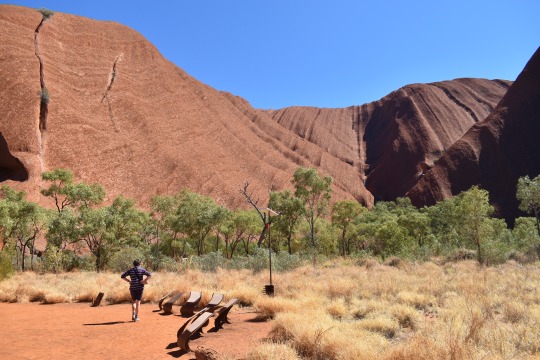
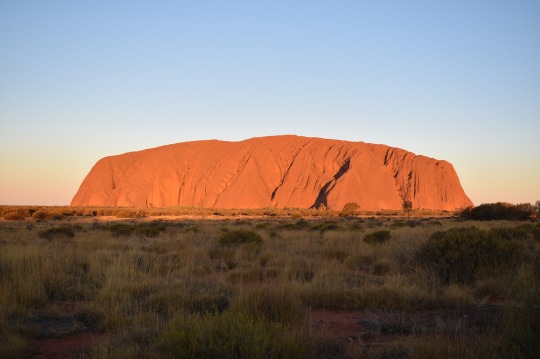
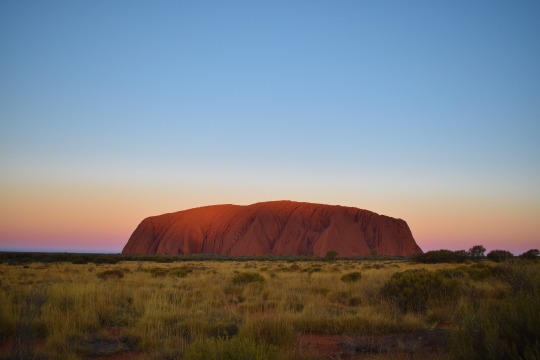
The other place of significance in the National Park is Kata Tjuta (the Olgas) which is a contrasting collection of rocks (the formation of both Uluru and Kata Tjuta seems to be still very much undecided so I’m struggling to know what to call them!). We did an absolutely stunning hike there called the Valley of the Winds with some breathtaking viewpoints.
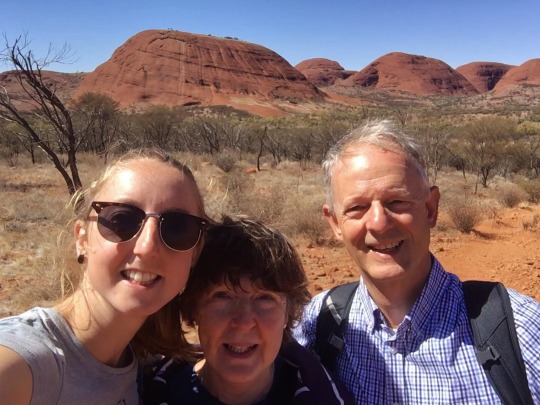
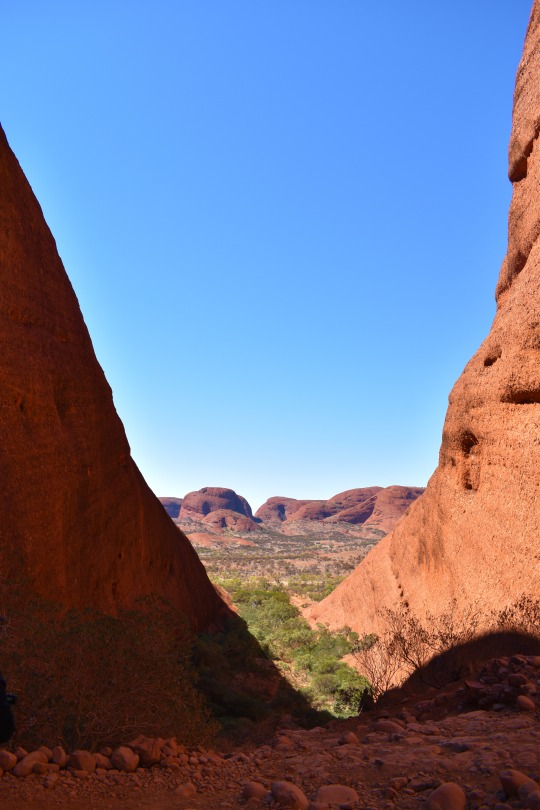
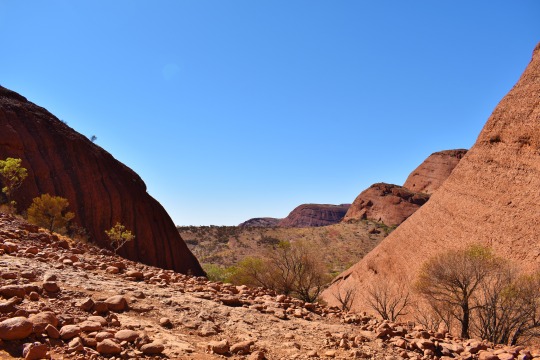
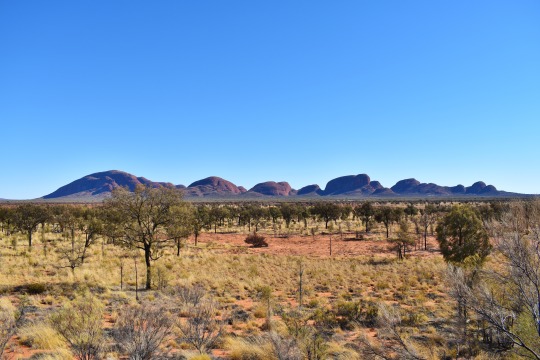


After lots of beautiful sunset viewings, we braved a very early start, armed with a thermos of hot tea, to drive into the Park to watch the sunrise. It was certainly a popular event but we could see why – watching the colours change over Uluru with Kata Tjuta in the distance was just spectacular!
Our legs were exhausted from a lot of hiking so we spent our last day going to workshops and talks put on by the resort, learning about bush tucker, aboriginal hunting tools and even a didgeridoo lesson!
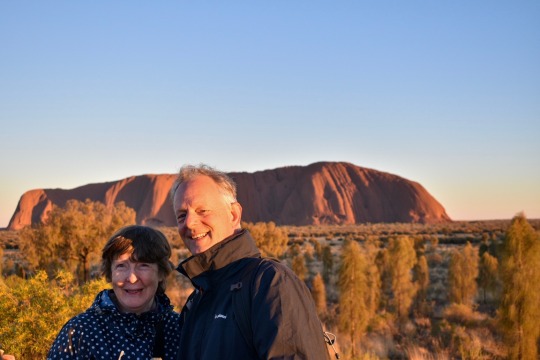


It was time to fly back to Newcastle but what a trip of a lifetime we’d been lucky to experience! It was great to finally show my mum around the place I’ve talked so much about over the past 5 years and to take her back to Sydney to see where they both lived 31 years ago, and meet up with some of their old friends!
Sadly, their life back in England called, so it was another goodbye but we parted ways with so many incredible memories to last a lifetime!
It was back to hospital life and the revision grind for me....
2 notes
·
View notes
Text
Top 5 Kid Friendly Caravan Parks

As summer winds down, the roads are becoming less crowded. Before settling into another year of work and school, why not bundle the family into the caravan for a getaway.
At Kakadu Annexes, we understand that family caravanning holidays should be fun, relaxing, affordable, and above all, kid friendly.
So, we’ve compiled a list of Queensland’s top five family friendly holiday parks.
Queensland Recreation Centres
Boasting two locations on the stunning Gold and Sunshine Coasts, Queensland Recreation Centre offers family friendly weekend and school holiday accommodation.
Both holiday parks feature self-contained rooms (with ensuites), which sleep up to seven people. Prices start from $84 per night, with no minimum stay required.
Read more : Top 5 Kid Friendly Caravan Parks
1 note
·
View note
Text
What Are The Top Must-See Attractions On Tours Of Kakadu National Park?

Kakadu is one of the most spectacular places in Australia. It's home to thousands of species of plants, animals and insects that have adapted to survive in this arid climate.
There are several ways to experience tours of Kakadu, including driving around on a 4WD tour or staying at one of our accommodation options for more freedom when exploring the park. Below are some of our favourite tours around Kakadu National Park:
Ubirr Rock Art Site
Ubirr Rock Art Site is a rock art site in the tours of Kakadu. It is located in Kakadu National Park, and was first discovered by researchers in 1974.
The area has been occupied by indigenous Australians for thousands of years, and its ancient rock art contains evidence of their lifestyle and culture.
The Ubirr Rock Art site is one of Australia's oldest sites featuring rock paintings, which date back more than 20,000 years. The paintings depict animals such as water buffalo (Bubalus bubalis), kangaroos (Macropus rufus), emus (Dromaius novaehollandiae) and dingoes (Canis lupus dingo).
Jim Dromaiids Falls
Jim Dromaiids Falls is a waterfall located in Kakadu National Park, an area that is home to many other popular attractions. It's also one of the most visited places in Kakadu National Park, so it's no surprise that there are plenty of things to see here!
Jim Dromaiids Falls has been called "the best thing about tours of Kakadu" and "the place where you should visit if you're going on vacation." You can take yourself back in time by exploring this waterfall with its natural pools and gushing waterfalls—it’s like stepping into another world!
Yellow Water Billabong
A billabong is a natural pool of water, usually fed by a spring or stream. Billabongs are often formed in arid regions where the soil is not easily permeable and water cannot drain away easily.
They can be found throughout Australia, but are most common in Kakadu National Park, where they're often used as a campsite for tourists who want to experience camping on this beautiful land.
If you're traveling with kids and want to get them excited about nature, then you should definitely check professional guided tours! This feature will give them an opportunity to explore the beauty of Australia's landscape while also learning about its people through stories told by local guides.
Nourlangie Rock
Nourlangie Rock is a rock formation located in the Nourlangie National Park, near Jabiru. It's a popular tourist attraction and sacred site for the Yolgnu people, who have been dealing with its effects for thousands of years.
The name "Nourlangie" means “fire” or “sunrise” in their language and refers to the time when sunrise happens over this rock formation every day (hence why it's also called Sunrise Rock).
Conclusion
There are many attractions in tours of Kakadu that you can visit on a tour. In this article, we have listed some of the most popular ones.
The best way to experience these places is by hiring a guide who knows their way around and can show you around in comfort. If you want to make sure your trip is safe and fun, then always make sure to do your research first before booking something!
Source Url: https://guidedtourpackages.blogspot.com/2023/05/what-are-top-must-see-attractions-on.html
0 notes
Text
Cost of Living in Australia For International Students
Australia boasts stunning landscapes including canyons and wide-open spaces, deserts, beaches, and coral reefs.
Students can visit the Great Barrier Reef, Kakadu National Park, and Lord Howe Island, Group.

Fraser Island, Tasmanian Wilderness, and Fraser Island are some of the other attractions.
Australia is home to the largest island in the world and is the third most visited international student destination.
Why Choose Australia for Study
Australia currently has nearly 700,000 international students. Australia is an attractive study destination due to its high-quality education, access to student support services, diversity, and lavish lifestyle.
According to the Times Higher Education World University Rankings, some of Australia's most prestigious universities include The University of Melbourne and Australian National University.
The country has a fantastic educational system, with more than 22,000 courses across 1,100 institutions.
If a student plans to study in Australia, it is important to understand the average cost to live in Australia. Planning your stay will be easier if you are financially prepared.
For overseas students, the average cost to study in Australia, including tuition fees, is AUD 20,000 to AUD 50,000 annually.
How much does it Cost of living in Australia for Students?
For international students, the cost of living in Australia is approximately AUD$21,000.
Australia has 7 cities that are ranked among the top 75 QS Best Students Cities.
Students can tag along with their partner for around AUD$7.400, while a child accompanying them will cost around AUD$3,200.
Other expenses such as phone and internet costs are important for students. They cost between $15 and $30 per week.
Students can get groceries for up to $280 per Week in Australia's organic and farmer markets. Entertainment costs around $80-$150 per week.
The average cost of living in Australia is between AUD1,400 and AUD2,500. Each student's monthly cost of living in Australia will vary depending on where they live.
How Much Accommodation Cost in Australia for International Students?
There are many options for students to choose from when it comes to lodging. Students can rent or lease a property. Students can rent or lease apartments in purpose-built student housing.
You can choose between shared or studio apartments. These houses are often located in central areas and near public transport, making it easy for students to move around the city.
Fully furnished and equipped university-operated housing is available, as well as facilities that include bills and integrated support.
These facilities offer outstanding pastoral care, academic help, and athletic, cultural, or leadership development opportunities.
International students should decide where they will be staying when planning to study in Australia. Students must include details about their accommodation during the academic year when applying for a visa.
Most Australian students live off-campus through homestay programs, hostels, and rental apartments.
How were good in Transport Services in Australia?
Australia is a huge country and students rely on public transport. International students will be able to get where they need to go, be it by bus, train, carpool, bike, or plane as the public transport system is very efficient.
Depending on where they live, students have different access to different transport services.
Students also have access to public and private transportation services ranging from taxis to rental cars to get to their destinations.
The cost of public transport Transportation will vary depending on where you live in Australia and the mode of transport used.
Some larger educational institutions also have their own transportation system, which is particularly beneficial when students need to leave campus late at night or live in a remote location.
Students can get discounts from certain areas and if they are on a scholarship or exchange program.
The average cost of public transportation is $30-$60 per week.
Best Cities to Study in Australia for International Students
The cost of living varies from country to country. Melbourne is Australia's most culturally important city and one of the most livable cities in the world.
In terms of graduate employability, it ranks first in Australia and fourth in the world. You have the opportunity to complete internships and internships with industry leaders and are supported in doing so.
Here are some of the reasons Melbourne is an ideal destination for students the cost of living in Melbourne Australia Melbourne costs around $430 for a week's rental and monthly public transport costs up to $155 per month.
Perth has one of the best living standards in the world and is still cheaper than many other places to study.
The Mediterranean climate has brought about perfect blue skies and a pollution-free atmosphere, a smaller population, and less traffic congestion.
Perth's cultural diversity, 40% discount on travel, and ranked 64th in cost of living according to The Economist Intelligence Unit's Global Cost of Living survey.
Work While Studying in Australia
When it comes to working while studying, Australian immigration laws are very straightforward.
A simple application can qualify you to work in Australia as an international student. Although laws may vary, students can typically work up to 40 weeks per year.
The other factor is the availability of part-time jobs in Australia, which are not in short supply.
Students are often hired by corporations, small businesses, and retailers (both national and international).
As an international student, the same employment regulations apply to you as a domestic student, including the minimum wage. As a student, you can expect to make around $17 an hour.
There is employment on and off campus. available, and many colleges have an office that can help you find the right one for you.
Students work in a variety of industries ranging from retail to hospitality to administrative and teaching positions.
It is worth noting that Australia offers excellent job opportunities for international students. Because of its numerous dynamics,
Australia provides a fresh and unique perspective in the field of education. Students contribute significantly to Australia's economy, the government is particularly concerned with education regulation, and many Australian institutions rank among the top 100 in the world.
The government offers various scholarships, grants, and awards to assist students and has spent over AUD 300 million.
Enjoy the coastlines and lead an adventurous life in Australia with our assistance.
Contact Get Study Supports and experiences a stress-free accommodation process.
Cost of Living in Australia FAQs
How much money do you need to live comfortably in Australia?
Answer: The cost of living in Australia for 12 months is approximately $21,000. The average monthly cost of living in Australia ranges from AUD1,400 to AUD2,500
Is Australia cheaper than the USA?
Answer: The average cost of living in Australia is higher than in the US. But, Australia is ranked second in the world in terms of quality of life.
Is Australia expensive to live in?
Answer: Australia is very affordable for students. You can choose from shared rentals or homestays starting at $95 per week.
How Many Bangladeshi live in Australia?
Answer: There are 41,000 Bangladeshis in Australia. The largest communities of Bangladesh are found in Victoria and New South Wales.
0 notes